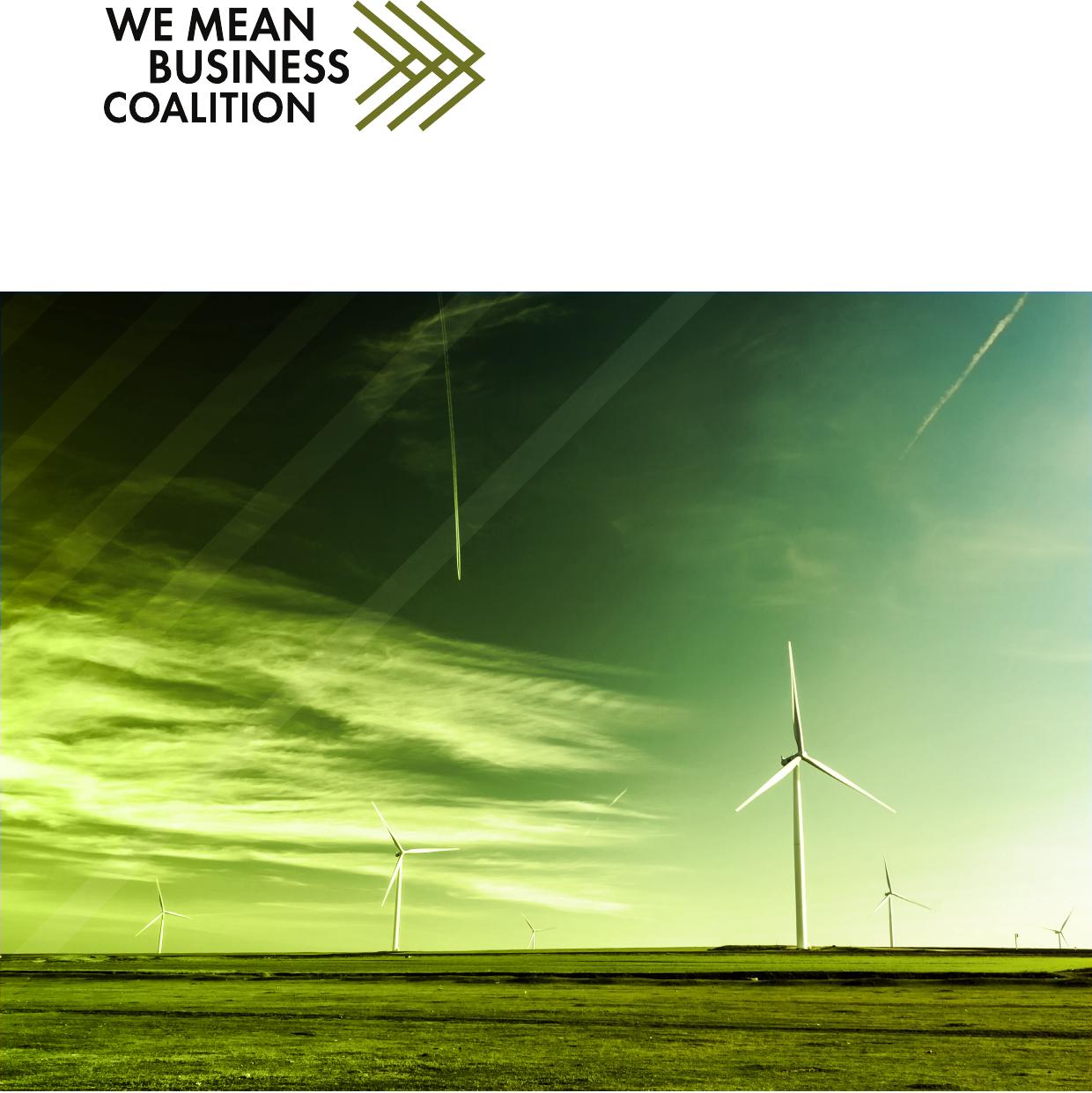EUGREENTAXONOMYINPRACTICEWHITEPAPER2023By:Dr.JaneThostrupJagdDirector,NetZeroFinance,WeMeanBusinessCoalitionCONTENTSExecutivesummary............................................................................................................................................................3..Introduction–purposeofanalyses.................................................................................................................................4...Thelegislation–recap.....................................................................................................................................................5..PurposeoftheEUGreenTaxonomy............................................................................................................................5..TheEUGreenTaxonomy’sconnectionstootherEUregulations...............................................................................5Disclosurerequirements.................................................................................................................................................7–Disclosurerequirementsfornon-financialundertakings......................................................................................7–Disclosurerequirementsforfinancialundertakings:.............................................................................................9.TheEUGreenTaxonomytimeline................................................................................................................................9.Methodandoverallanalyses..........................................................................................................................................10Analysesofthenon-financialcompanies’reports.........................................................................................................1..2Theissuesofthecomplicatedtabularforms................................................................................................................1.2Theissueoflackofactivity-definition...........................................................................................................................14Theissueoffinancialmateriality...................................................................................................................................1.6Theissueofrelevance....................................................................................................................................................1.7Bonds..............................................................................................................................................................................1..8Analysesofthefinancialcompanies’reports.................................................................................................................2.0Theissueofproportions.................................................................................................................................................20Theissueoftiminganduseofestimates.......................................................................................................................2.2Theissueofpurpose–thebigwhy?............................................................................................................................2.3Bonds..............................................................................................................................................................................2..4Conclusionsandrecommendations.................................................................................................................................2..5.Referencelist......................................................................................................................................................................27AppendixI:Copyofthefirstpartofthetabularformforthenon-financialundertakings..........................................2..9AppendixII:Accumulatedactivityvaluesofthenon-financialcompanies..................................................................30AppendixIII:Copyofoneofthetabularformsforthefuturefinancialcompanyreporting......................................3.6AppendixIV:Overviewofcompaniesincludedintheanalyses...................................................................................3.7Disclaimer:Theshowninformationinthiswhitepaperisonlyasummaryofselectedregulatorytopicsanddates.Itisnotbindingandthereisnoclaimtocompleteness.EUGREENTAXONOMYINPRACTICE–Whitepaper20232EXECUTIVESUMMARYTheEUGreenTaxonomyiscurrentlybeingrolledout,anditaimstodefinewhichofacompany’sactivitiesare‘green’,therebymakingiteasierforfinancialcompaniestofunnelcapitaltowardsgreencompanies/projectswhileminimizingtheirrisksofgreenwashing.Theideaisagoodone–buthowistheimplementationgoinginpractice?WeMeanBusinessCoalitionhasinthiswhitepapersoughtgreaterinsightsintowhattheEUGreenTaxonomyreportingpracticeisforbothfinancialandnon-financialcompanies.Wehavedoneso,becausethelegislationhasbeencriticizedfornotbeingaccurate,andattimesnotbeingrelevantforthosecompaniesthatarerequestedtoreport.Wehaveanalyzedthe100largest,listedEUcompanies’Taxonomyreporting,bothtoseehowtheyapplythenewlegislationatitscurrentstage–itisnotfullyimplementedyet–butalsotoinvestigateifthelegislationcouldbebetterandmorepreciselydefined.WehavealsoanalyzedwhethertheTaxonomyactivitiesarerelevantforthecompaniesbeingaskedtoreport.Fromouranalysiswefindbothgoodpracticeandthingsthatneedattention.Wehaveidentifiedareasofimprovementforbothnon-financialcompaniesandfinancialcompanies.Wealsofindlegislationthatcouldbemorepreciseandthatcouldoftenbedrasticallysimplified.Inshort,ourfindingsreveal:•Financialandnon-financialcompaniescandobetterinapplyingtheregulations;•Regulatorscandobetterindefiningkeytermsinthelegislationtominimizeverydifferentinterpretations,andviasimplifyingthereportingrequirements–henceincreasingcomparableandusefulreporting;•Regulatorscanincreaserelevancebyeitherdevelopingsignificantlymoretaxonomyactivities,orbynarrowingthereportingburdentospecificrelevantsectors.Thegoodnewsisthatallthecompanies’reportsthatwelookedatrefertotheTaxonomy,andtheypublishinformationintherightreports.Theyeven,toalargeextent,getvoluntaryassurance,justasmanycompaniesalreadyworkwith/issueTaxonomylabelledbonds.GiventhattheEUGreenTaxonomyisnotfullyimplementedyet,thisisapositivesign,anditgivesgreathopethatinvestmentcanflowintobusinessesthatareleadingthewayonclimateactioninEurope,atthespeedandscalenecessaryforhalvingglobalemissionsby2030.Withadjustmentstosomeofthepracticesbycompaniesandrevisionstothelegislation,reportingcanbemadetrulyuseful.EUGREENTAXONOMYINPRACTICE–Whitepaper20233INTRODUCTION–PURPOSEOFTHEANALYSESThiswhitepaperseekstoinvestigatehowthenewEUGreenTaxonomyreportinglegislationisworkinginpractice.ManycompaniesaffectedbythenewruleshavecommentedthattheEUGreenTaxonomyisnotalwayspreciseenough1.Inthe100reportsanalyzedforthiswhitepaper,35ofthemmentionhowthelegislationis‘stillupforinterpretation’orsomethingsimilar.Hereisanexampleofacommoncomment:TheEUTaxonomyRegulationandtheDelegatedActsissuedthereundercontainwordingandtermsthatarestillsubjecttoconsiderableinterpretationuncertaintiesandforwhichclarificationshavenotyetbeenpublishedineverycase.Therefore,managementhasdisclosedtheirinterpretationoftheEUTaxonomyRegulationandtheDelegatedActsadoptedthereunderinsection“SustainableFinance:EUTaxonomyDisclosures”ofthecombinednon-financialstatement.’(Anonymizedcompany)Thesameisalsorelevantfortheassurancestatementsgiven,astheyaremostoftenprovidedwithsomesortofdisclaimeraboutthelackofregulationclarity.Forinstance:‘Duetotheimmanentriskthatundefinedlegaltermsmaybeinterpreteddifferently,thelegalconformityoftheirinterpretationand,accordingly,ourassuranceengagementthereonaresubjecttouncertainties.’(Anonymizedauditor)Thispaperwillinvestigatethereportingpractice.Wewillfocusonwhetherthereportingpracticeappearstobeinlinewiththeregulationornot–oriftheregulationissoimpreciseatitscurrentstage,thatthecomparabilityandusabilityofthereportsmadebycompaniesisjeopardized.Theanalyseswillalsofocuson,whethertheactivitiesincludedintheEUGreenTaxonomyappeartoberelevantandusefulforthemajorityoflarge,listedcompanies,whocurrentlyarecoveredbytheregulation.AretherightactivitiesincludedintheEUGreenTaxonomyforthecompaniesthatarerequiredtoreport?Thispaperaimstoprovideadviceforbothcompanies2andtheEuropeanCommissionaboutpotentialimprovements,todeliveronourcollectivegoalsofreducingcorporateemissions,andmakingiteasierforinvestorstoknowwhicharethegreenestcompanies/projectsinEurope.Wewillnotrefertoanyspecificcompanyreportinthepaper,asthereisariskofdilutingandderailingthedialogueaboutpotentialimprovementsfromthegenerictospecificincidents,whichisnotthepurpose.1.SeealsoPlatformonSustainableFinance(2022b)andJagd(2022)2.Thereportingadvicecouldpotentiallyalsobehelpfulforthecompanies’assuranceprovidersandthenationalbusinessauthorities.EUGREENTAXONOMYINPRACTICE–Whitepaper20234THELEGISLATION–RECAPTheEUGreenTaxonomyistheshortnameforthisregulation:Regulation(EU)2020/852oftheEuropeanParliamentandoftheCouncilof18June2020ontheestablishmentofaframeworktofacilitatesustainableinvestment,andamendingRegulation(EU)2019/2088.PURPOSEOFTHEEUGREENTAXONOMYTheEUGreenTaxonomyisaclassificationsystemthatwilldefinecriteriaforeconomicactivitiesthatarealignedwithanetzerotrajectoryby2050andthebroaderenvironmentalgoalsotherthanclimate.TheEUGreenTaxonomywillexplainforeachsector,whicheconomicactivitiesaregreen,andwhicharenot.Thisshouldmakeitcleartowhatdegreethecompany,projectorinvestmentportfoliocomplieswiththeEUGreenTaxonomy.TheintentionswiththeEUGreenTaxonomyare3:•Tocreateaframeofreferenceforinvestorsandcompanies;•Tosupportcompaniesintheireffortstoplanandfinancetheirtransition;•Toprotectagainstgreenwashingpractices;•Tohelpacceleratefinancingofthoseprojectsthatarealreadysustainableandthoseneededinthetransition.‘Largefinancialandnon-financialundertakings4canusetheinformationdisclosedtodesigncrediblegreenfinancialproductssuchasgreenbondsorinvestmentfundsand,throughthepublicdisclosuresundertheDelegatedAct,channelinvestordemandtowardssustainableprojects’(SupplementingRegulation(2021),p3).THEEUGREENTAXONOMY’SCONNECTIONSTOOTHEREUREGULATIONSIn2018,theEUannouncedacomprehensivepackage5calledtheEUActionPlan,proposingtenreformsinthreeareas,whichshouldencourageinvestorstodirectmorecapitalintoactivitiesandsectorsthatmaketheeconomymoresustainableandcansecuresustainablegrowth.•Reorientcapitalflowstowardssustainableinvestment,inordertoachievesustainableandinclusivegrowth◦EstablishinganEUclassificationsystemforsustainabilityactivities◦Creatingstandardsandlabelsforgreenfinancialproducts◦Fosteringinvestmentinsustainableprojects◦Incorporatingsustainabilitywhenprovidinginvestmentadvice◦Developingsustainabilitybenchmarks3.EUTaxonomyNavigator(europa.eu)4.Undertakings–atechnicaltermusedintheregulationstorefertocompaniesorenterprisesthataretoundertakereporting.Inthischapteraboutthelegislation,wewillthereforeusethisterm–butinthemorepracticeorientedanalyses-chapter,wewillusethemorecommonword:companies.5.https://finance.ec.europa.eu/publications/renewed-sustainable-finance-strategy-and-implementation-action-plan-financing-sustainable-growth_enEUGREENTAXONOMYINPRACTICE–Whitepaper20235•Mainstreamingsustainabilityintoriskmanagement◦Betterintegratingsustainabilityinratingsandresearch◦Clarifyinginstitutionalinvestorsandassetmanagers’duties◦Incorporatingsustainabilityinprudentialrequirements•Fostertransparencyandlong-termisminfinancialandeconomicactivity◦Strengtheningsustainabilitydisclosureandaccountingrule-making◦Fosteringsustainablecorporategovernanceandattenuatingshort-termismincapitalmarketsAscanbeseen,theEUGreenTaxonomyisthefirstreforminthispackage,andisthecornerstoneofasuiteofnewlegislationsandregulations,anditmaybehelpfultounderstandtheirconnections:1.EUTAXONOMYAcommonclassificationofeconomicactivitiescontributingtoclimateandenvironmentalobjectives•TaxonomyRegulation:appliessinceJuly2020•ClimateDelegatedActandDisclosuresDelegatedActapplysinceJanuary2022•ComplementaryClimateDelegatedActappliessinceJanuary2023•EnvironmentalDelegatedActadoptedbytheCommissioninJune2023,duetoapplyfromJanuary20242.DISCLOSURES3.TOOLSComprehensivediscosureregimeforbothBroadtoolboxforcompanies,marketnon-financialandfinancialinstitutionstoparticipantsandfinancialintermediariesprovideinvestorswiththeinformationnecessarytodevelopsustainableinvestmenttomakesustainableinvestmentchoicessolutionswhilepreventinggreenwashing•BenchmarkESGdisclosuresapplysinceApril2020•EUClimateBenchmarksRegulationappliessince•SustainableFinanceDisclosureRegulations(SFDR)April2020appliessinceMarch2021•RegulationforaEUGreenBondStandard(EUGBS),•SustainabilitypreferencesapplysinceAugust2022politicalagreementreachedinFebruary2023•CorporateSustainabilityReportingDirective(CSRD):firstcompaniesreportforfinancialyear2024ESGratingsprovideanassessmentabouttheESGcharacteristics,exposurestoESGriskorimpactsofanentity,afinancialinstrumentorafinancialproduct•RegulationonESGratingsprovidersproposedbytheCommissioninJune2023Figure1:EUGreenTaxonomyandallthenewlegislationsandregulations,source:CommissionStaffWorkingDocument317(13.06.2023)TheEUGreenTaxonomyisthedriverofmanyotherpiecesoflegislation,thereforeitisessentialthatboththefinancialandnon-financialundertakingsunderstandthepurposeandtheuseoftheregulationanddisclosurerequirements.EUGREENTAXONOMYINPRACTICE–Whitepaper20236DISCLOSUREREQUIREMENTSTheEUGreenTaxonomyappliestoundertakingssubjecttotheobligationtopublishnon-financialstatementsinaccordancewiththeNon-FinancialReportingDirective(NFRD)6.Thedisclosurerequirementsaredifferentiatedbetweenthenon-financialandfinancialundertakings.FinancialundertakingsarethosethatofferfinancialproductsintheEU.Sometimesundertakingscanfallintobothcategories(dependingontheirsizeandeconomicactivities),butitisnotcommon.Theonlycommonruleforbothfinancialandnon-financialundertakingsisthattheTaxonomyreportingmustbepartofthereportingofnon-financialstatements,oritshallprovidecross-referencestothis.Disclosurerequirementsfornon-financialundertakings:TheEUGreenTaxonomycoverssixenvironmentalobjectives:•climatechangemitigation•climatechangeadaptation•thesustainableuseandprotectionofwaterandmarineresources•thetransitiontoacirculareconomy•pollutionpreventionandcontrol•protectionandrestorationofbiodiversityandecosystemsForthereportingyear2022,itwasonlythetwofirstobjectives,climatechangemitigationandadaptation,thatwereinforce.Theyaredefinedasfollows:•Climatechangemitigationactivitiesshouldcontributesubstantiallytothestabilizationofgreenhousegasemissionsbyavoidingorreducingthemorbyenhancinggreenhousegasremovals(EUGreenTaxonomy,para24).•Climatechangeadaptationactivitiesshouldcontributesubstantiallytoreducingorpreventingtheadverseimpactofthecurrentorexpectedfutureclimate,ortherisksofsuchadverseimpact,whetheronthatactivityitselforonpeople,natureorassets(EUGreenTaxonomy,para25).Forthereportingyear2022climatechangemitigationandadaptationcoveredatotalof101economicactivitiesspanningover12economicsectors7.Thenon-financialundertakingsaretoidentify,iftheycontributesubstantiallytoatleastoneofthetwoobjectives(nextyearsixobjectives)–theseactivitiesarecalledeligibleactivities.Theseeligibleactivitiesarethentobeassessedfor,whethertheyarealignedwiththeEUGreenTaxonomy.Thatisdonebyassessingwhethertheactivity:•Contributessignificantlytooneormoreofthesixenvironmentalobjectives•Doesnosignificantharmtoanyoftheotherfiveenvironmentalobjectives(alsoknownasDNSH)•Complywithminimumsafeguards(meaninginlinewithOECDGuidelinesforMultinationalEnterprisesandUNGuidingPrinciplesonBusinessandHumanRightstonothaveanegativesocialimpact)•ComplywiththetechnicalscreeningcriteriasetoutintheTaxonomydelegatedacts8.6.Fromthereportingyear2023,allcompaniesthatfallundertheCorporateSustainableReportingDirective(CSRD)willberequiredtoreportaccordingtotheEUGreenTaxonomy.Sincethiswillgraduallybeenlargedtocovermorethan50,000companies,theamountoftaxonomyreportingwillalsoincreasesubstantially.7.Fromthereportingyear2023,thefourremainingobjectiveswillbeinforce,anditistheexpectationthatneweconomicsectorsandactivitieswillcontinuetobeaddedandexistingonesrefinedandupdatedwhereneeded.SeemoreintheEUGreenTaxonomyandthesupplementadoptedinJune2023.Toseeanoverviewofthecurrentactivitycodes,seethis:sustainable-finance-taxonomy-nace-alternate-classification-mapping_en.xlsx(live.com)8.SeemoreintheClimateDelegatedAct(2021)andComplementaryClimateDelegatedAct(2021)EUGREENTAXONOMYINPRACTICE–Whitepaper20237Thenon-financialundertakingshall9providetheTurnover,OperationalExpenditures(OpEx),andCapitalExpenditures(CapEx)dataper:•Eligibleandalignedactivity•Eligiblebutnon-alignedactivity•Non-eligibleactivitiesAllnon-financialundertakingsshallusethetabularformbyusingthetemplatessetoutinAnnexIIoftheDisclosureDelegatedAct(2021)10–eveniftheydonothaveanyTaxonomyeligibleactivities.TheDisclosureDelegatedAct(2021)definesthethreefinancialelementsthisway:•TheTurnover11shallcovertherevenuerecognizedpursuanttoInternationalAccountingStandard(IAS)1,paragraph82(a),asadoptedbyCommissionRegulation(EC)No1126/2008.•CapExshallcoveradditionstotangibleandintangibleassetsduringthefinancialyearconsideredbeforedepreciation,amortization,andanyre-measurements,includingthoseresultingfromrevaluationsandimpairments,fortherelevantfinancialyearandexcludingfairvaluechanges.Itshallalsocoveradditionstotangibleandintangibleassetsresultingfrombusinesscombinations.So,CapExshallcovercoststhatareaccountedbasedon:(a)IAS16Property,PlantandEquipment,paragraphs73,(e),point(i)andpoint(iii);(b)IAS38IntangibleAssets,paragraph118,(e),point(i);(c)IAS40InvestmentProperty,paragraphs76,points(a)and(b)(forthefairvaluemodel);(d)IAS40InvestmentProperty,paragraph79(d),points(i)and(ii)(forthecostmodel);(e)IAS41Agriculture,paragraph50,points(b)and(e);(f)IFRS16Leases,paragraph53,point(h)•OpExshallcoverdirectnon-capitalizedcoststhatrelatetoresearchanddevelopment,buildingrenovationmeasures,short-termlease,maintenanceandrepair,andanyotherdirectexpendituresrelatingtotheday-to-dayservicingofassetsofproperty,plantandequipmentbytheundertakingorthirdpartytowhomactivitiesareoutsourcedthatarenecessarytoensurethecontinuedandeffectivefunctioningofsuchassets.Non-financialundertakingsthatapplynationalGAAPandarenotcapitalizingright-of-useassetsshallincludeleasecostsintheOpExinadditiontothecostslistedinthefirstsubparagraphofpoint1.1.3.1ofAnnexIoftheDisclosureDelegatedAct(2021).Thenon-financialundertakingshallalsoprovideaccountingpoliciesandmethodologiesused,provideinformationonassessmentofcompliancewiththeregulation,andhowtheyavoiddouble-countingandmakereconciliationstowardsthefinanciallineitems.ThereiscurrentlynoEUrequirementforassuranceoftheTaxonomyreporting12.9.Thereisanexemption-possibilitynottoprovidetheOpExactivitysplit,iftheOpExisnotmaterialforthebusinessmodel.Butifthisexemptionisused,thetotalvalueofOpExmuststillbedisclosedinthetabularformandanexplanationoftheabsenceofactivity-splitmustbegiven.10.SeeDisclosureDelegatedAct(2021)Article2(2)11.TurnoveristypicallycalledRevenueinthefinancialreportinglegislation.12.OncetheCSRDreportingapply,accordingtothephasedsolutionsforthis,limitedassuranceoftheTaxonomyreportingwillalsoapply,asfortherestoftheCSRDreporting.SeealsoFAQnumber4ofEuropeanCommission(2022)EUGREENTAXONOMYINPRACTICE–Whitepaper20238Disclosurerequirementsforfinancialundertakings:Thedisclosurerequirementsforfinancialundertakingsarequitedifferentfromtherequirementsforthenon-financialundertakings,asTurnover,CapExandOpExareirrelevantforassessingthefinancialactivities,includinglending,investment,andinsurance.ThespecialfinancialundertakingdisclosurerequirementscanbefoundintheSupplementingRegulation(2021),whichisbasedonArticle8oftheEUGreenTaxonomyRegulation(2020).Thefinancialundertakingsarenottousethesametabularformasthenon-financials,butinsteadtheyhavetheirowntabularforms,whicharedifferentdependentonthetypeoffinancialundertaking:•Assetmanagers•Creditinstitutions(incl.banks)•Investmentfirms•InsurersandreinsurersMostreportingrequirementsforthefinancialundertakingskickinfromreportingyear2023orlater,butthefewrequirementsforreportingyear2022willofcoursebeinvestigated.Theyare:(a)theproportionoftheirtotalassetsexposedtoTaxonomynon-eligibleandTaxonomy-eligibleeconomicactivities;(b)theproportionoftheirtotalassetsoftheexposuresreferredtoinArticle7,paragraphs1and2;(c)theproportionoftheirtotalassetsoftheexposuresreferredtoinArticle7(3);(d)thequalitativeinformationreferredtoinAnnexXI;(e)Creditinstitutionsshallalsodisclosetheproportionoftheirtradingportfolioandondemandinter-bankloansintheirtotalassets;(f)InsuranceandreinsuranceundertakingsshallalsodisclosetheproportionofTaxonomy-eligibleandTaxonomynon-eligiblenon-lifeinsuranceeconomicactivities.THEEUGREENTAXONOMYTIMELINETheEUGreenTaxonomyhasbeeninforcesince12thJuly2020,andfollowsthebelowprogressionofdisclosureobligationsaccordingtotheDisclosuresDelegatedAct13supplementingArticle8oftheEUGreenTaxonomyregulation.AsofJanuary2022•Non-FinancialentitiesreportTaxonomyelegibilityforthepreviouscalendaryear•FinancialentitiesreportTaxonomyelegibilityforthepreviouscalendaryearAsofJanuary2023•Non-Financialentitiesreportelegibilityandalignmentforthepreviouscalendaryear•FinancialentitiesreportTaxonomyelegibilityforthepreviouscalendaryearAsofJanuary2024•Non-Financialentitiesreportelegibilityandalignmentforthepreviouscalendaryear•FinancialentitiesreportTaxonomyelegibilityandalignmentforthepreviouscalendaryearAsofJanuary2025•FinancialentitiesmayincludeestimatesonTaxonomyalignmentforDNSHassessmentsofthird-countryexposuressubjecttothe2024reviewperiodAsofJanuary2026•CreditinstutionsincludeTaxonomyalignmentoftheirtraidingbookandfeesandcommisionsfornon-bankingactivitiesFigure2:ThereportingobligationsandtimelinesassetoutintheDisclosuresDelegatedAct,source:https://ec.europa.eu/sustainable-finance-taxonomy/13.https://eur-lex.europa.eu/legal-content/EN/TXT/?uri=CELEX:32021R2178EUGREENTAXONOMYINPRACTICE–Whitepaper20239METHODANDOVERALLANALYSESThiswhitepaperinvestigateshowthenewEUGreenTaxonomyreportinglegislationisworkinginpractice.WehaveanalyzedtheTaxonomyreportingforthe100largest,listedcompaniesinEU,whichweresubjecttoreportfromthereportingyear2022.WehaveidentifiedthecompaniesviaForbes’TheGlobal2000listfrom2023,whichisbasedon2022reporting,whereForbesranklistedcompaniesbasedtheirSales,Profit,Assets,andMarketvalueinUSD.SeetheAnnextofindalistofthecompaniesincludedintheanalyses.WehaveaddedtheofficialGICS-codes(GlobalIndustryClassificationStandard)aswell,wherebypotentialsectorrepresentationscanalsobefound.All100companieshavebeenanalyzedviamanualreadingandanalysesoftheirsustainability/integrated/UniversalRegistrationDocument2022reports,astheywerefoundonthecompanies’homepagewithadeadlineof30thJune2023.Wehavedevelopedandusedastandardanalysestemplate,whichwebasedonatrialanalysesoftencompanies’reports.Wehavealsogatheredandconsolidatedtheactivityreportingfromallthenon-financialcompanies’reportsperactivitylevel,wherebywecanseethetotaleligible&aligned,theeligiblebutnon-aligned,andnon-eligibleTurnover,CapExandOpExfromthenon-financialcompanies(seeAppendixII).Finally,wehavealsoaccumulatedthemandatoryfinancialcompanyreportingasfaraspossible–seethechapter‘Issueonproportions’withintheanalysesofthefinancialcompanyreporting.Thegeographicalsplitisreasonablewithrepresentationof15differentcountriesoutofthe27EUMemberStates.However,EasternEuropewithonlytwocompaniesisnotwellrepresented,duetothelimitednumberoflarge,listedcompanieswithheadquartersinEasternEurope.GivenasearchontheForbeslist,toseeifwereasonablycouldaddextraEasternEuropeancompaniestomaximizerepresentation,itbecameclearthatthenextonesonthelistaresignificantlysmaller,andwewouldthenjustaddmorenoiseratherthanclaritygiventhedifferentsizesofcompanies.Thus,wehavechosennottoaddadditionalEasternEuropeancompanies.No1:GeographicalsplitofcompaniesAustriaNoofcompaniespercountryMarketvaluepercountryBelgiumBill.EURCzechRepublic333Denmark2148Finland128France5460Germany4116Ireland292,324Italy251,339Luxembourg134Netherlands6239Poland120Portugal5385Spain117Sweden12183678252Total1005,783EUGREENTAXONOMYINPRACTICE–Whitepaper202310userid:246491,docid:149426,date:2023-12-24,sgpjbg.comTheGICSsectorsplitisquitediversewithrepresentativesfromtenoutoftheelevenstandardGICS,leavingonlyRealEstateasnotrepresented.Wethereforeconcludetheseanalysesareasgoodasfullysector-representative.No2:GICSsplitCommunicationServicesNoofcompaniesperGICSsectorMarketvalueperGICSsectorConsumerDiscretionaryBill.EURConsumerStaples4185Energy111,246Financials8557HealthCare6273Industrials27917InformationTechnology6706Materials16784Realestate5457Utilities52020012455Total1005,783GICS=GlobalIndustryClassificationStandardGICS-classificationcodesAccordingtothecompanyoverviewthereare27financialcompaniesasdefinedbytheGICScategories–buttwoofthemarenotofferinganyfinancialproductstothemarket,sotheyareconsideredasnon-financialcompaniesinthispaper,andtheyalsoreportaccordingly.Hence,thereare75non-financialcompaniesand25financialcompaniesinthisanalysis.14.‘ThetotalpopulationofcompanieswithinthescopeoftheNFRDintheEU27wasin20201,956(excludingexemptedsubsidiaries),madeupof1,604listedcompanies(excludinglistedbanksandlistedinsurancecompanies),278banksand74insurancecompanies.’(EuropeanCommission,2020,p8).Testing100companies’reportsgivesusaconfidencelevelof95%,anerrormarginof+/-9.55%,assumingthepopulationproportionis50%.Evenifweassumethepopulationis11,500(excludingexemptedsubsidiaries),whichwouldbethecaseifthecompaniesthatareaddedthroughnationaltranspositionoftheAccountingDirectiveandNFRDarealsoconsidered–thentheerrormarginonlyincreasesto9.76%.Hence,weconcludeasampleof100issatisfactoryforourpurpose.Itcanrightlybearguedthatthe100largest,listedcompaniesarenotsize-wiserepresentativefortheentirepopulation.Buttheimportanceofthesecannotbediscussed.15.NinecompaniesweretakenoutsincetheyarelistedoutsideofEUonnon-EUregulatedmarkets,andhence,currentlynotcoveredbytheTaxonomyregulation.TheywerereplacedwiththenextEU-headquarteredcompaniesinForbesranking.EUGREENTAXONOMYINPRACTICE–Whitepaper202311ANALYSISOFTHENON-FINANCIALCOMPANIES’REPORTSAllthe75non-financialcompaniesrefertotheTaxonomy,whichispositive.Butsevenofthecompaniesreportsopoorly,thatwemustconcludetheydonotfulfilthebasicformalrequirements.Fiveofthosesevencompaniesdonotprovideanyquantitativedataanddonotusethemandatorytabularforms.Twocompaniesdoprovidesomequantitativedata,buteitherinventtheirownmuchsmallerformsorsimplyprovidethedatainthetext.Itisnotsatisfactorythat9%oftheselarge,listedcompaniesdonotfulfileventhemostbasicformalmandatoryelements.Wealsotestedtoseewherethereportingisplaced.Thelegislationisclearthatthereportingmustbeplacedalongsidethenon-financialreporting.Allcompaniesgotthatright.Wesee17%reportinsustainabilityreports,50%reportinintegratedreports,andtherestinUniversalRegistrationDocuments–thelatterespeciallyisverymuchaFrenchsolution.Onecompanyunfortunatelydidnotprovideallelementsinonereport,sowehadtopiecethereportingtogetherfromboththesustainabilityandtheintegratedreport–thisisnotagooduser-friendlysolution.Allcompaniesthatreportquantitativedata(70ofthe75reports)alsoprovide,insomeshapeorform,themandatoryaccountingprinciples.Butregardingthemandatoryreconciliationsandreferencestothefinancialreporting(seeDisclosureDelegatedAct(2021),AnnexI,1.2.1),thesearestillnotoftenverywellmade(85%coulddobetter–somealotbetter).However,someFrenchandGermancompaniesespeciallyaregoodatmakingexplicitreconciliationsandreferencestotheirfinancialreport.Thisisasimpleandimportantimprovement,whichthecompaniesshouldbeabletodo,alsowiththecurrentlegislation.Asindicated,itisstillnotEUmandatedtogetassuranceoftheTaxonomyreporting.Yet,weactuallysee30companies(40%)thathavechosenvoluntarilytogeteitherlimitedorevenreasonableassuranceoftheTaxonomyreporting.Itisalsointerestingtoseethatofthe45companies,whodonotgetanyTaxonomyassurance,onlytwodonotgetanyassuranceoftheirsustainabilityreportingassuch,while43dogetsomeassurance,butwhichdoesnotcovertheTaxonomyreporting.THEISSUESOFTHECOMPLICATEDTABULARFORMSAsweindicatedatthebeginningofthischapter,companiesareexperiencingissueswithusingthemandatorytabularforms.Forthereaders’convenience,wehaveincludedacopyofthefirstsection-templateoftheseformsinAppendixI,wherebyitispossibletofollowtheheadersandnumbersofeachcolumnoftheforms,whenwegothroughtheissuesinthissection.TheycanalsobefoundintheirentiretyintheDisclosureDelegatedAct(2021),AnnexII.Lookingatall75non-financialcompanies’reports,45(60%)successfullymakeuseoftheformswithoutanyobviousshortcomings–but40%dohaveissuestosomedegree.Thatisalotofissues.Firstly,severalcompaniesfailtousetheformsatall,aspreviouslymentioned.EUGREENTAXONOMYINPRACTICE–Whitepaper202312Alesssevere,butyetpracticalissue,arisesaroundtheuseofactivitycodesincolumn2.Mostcompanies(56or75%)usetheDelegatedActcodes,astheyshould.Wealsoseeeightcompanies,whichbothprovideDelegatedActcodesandNACEcodes16,wherebytheymakethingsunnecessarilycomplicatedforthemselves.Butwealsoseeafewcompanies,whoonlyprovideNACEcodes,whichisnotright,butnotcompletelyimpossibletouse,sinceaneagerreportusercanviaamapping17tableusually18findtherightcodes–butitisofcoursenotuser-friendly.Theworstissueweseeisthatafewcompanies,whointhelackofactivitiestheywouldhavelikedtobeincludedintheTaxonomy,simplyinvent,andusehomemadeactivitiesordonotprovideanycodesbutjustaddnumberstothevariouscategoriesofdata.Thisisunacceptable.Anotherissuearisesfromtheuseofthecolumns5-10on‘substantialcontribution’.Theintentionwiththesecolumnsisthatthecompanyshoulddefine,whichofthetwo(nextyearsix)environmentalobjectivestheactivitycontributessubstantiallyto.Ascanbeseen,theunitisapercentage,andmostcompaniesdowhattheyshould,namelyassignhowmuchoftheactivitycontributestotheindividualobjectives,whichshouldaddupto100%peractivity–toensuretheactivityisnotdoublecounted.Butafewcompanies‘copy-paste’the%fromcolumn4,theproportionofTurnover,CapExorOpEx–whichiswrong.Butfundamentallyonecouldask,whymaketheformsocomplicated?Ifthecompaniesdidmakethereconciliationstothefinancialreportinglineitems,astheyshould(seepreviously),therewouldbenoriskofdouble-counting–itwouldtallyallthetime–thencolumns5-10areredundant.Thelastissuewiththeformswewouldliketohighlight,concernscolumns11-16,whicharerelatedtotheDNSHassessmenttowardstheotherobjectives.Notallactivitieshaverequirementsforall6DNSH-elements(ComplementaryClimateDelegatedAct(2021),AnnexI)–butyet,wefairlyoftenseecompaniesfillinallfieldsintheDNSHcolumnswitha‘Y’,indicating‘yes’,theyarealignedoneverything–andnota‘N/A’,‘-‘,orsimplyblankspaces,whichtheyshouldhaveusedwheretherearenoDNSHrequirements.Itisobviouslywrong,andperhapsitindicatesthecompanydidnotreadandassesstheDNSHrequirements,butjustassumedtheywerealignedoneverything.Butanotherandperhapssimplerexplanationcouldalsobethatthecompaniesjustthought,itlooked‘better’tobe100%alignedoneverythinganddidnotleaveanythingopen/blank/unanswered.Butonefundamentalquestionshouldberaisedaboutthesecolumns–whatisthepurposeofthem?Whoisgoingtousethem–andforwhat?Asgivenbytherules,ifjustoneoftheDNSH-requirementsarenotfulfilled,thentheactivityisnotaligned–butonlyeligible.Thatmeans,itisgiventhatallrelevantDNSHrequirementsarefulfilled,iftheactivityisassignedtobealigned–itisanimplicitconclusion–nofurtherexplanationisneeded,andcolumns11-16areredundant.Givenallthesepracticalproblemsandredundantinformationinthetabularforms,wewonderifitwouldbebeneficialandprovidemuchmoreusefulreporting,iftheseformsweredrasticallysimplified.Wealsowonder,whowilluseallthesecomplicatedelements,whenevaluatingthecompanies’taxonomyactivities–andhow?Infact,wewouldsuggestthatcolumns5-17and19-21areremoved.Ifthereasonforhavingallthesecolumnsisrelatedtothefactthatthelegislatorsdonottrustthecompanieswillreportcorrectly(andaswecanseefromabove,thatassumptionissometimesnotcompletelywrong),thenawaitthemandatorylimitedassurance19-donotcompensatebymakingtherequirementsovercomplicated.Butwhenmandatoryassurancekicksin,itwillontheothersidealsorequirebetterandmorepreciseregulationfromthelegislators.Thiswillalsoensurethattheassuranceprovidersdonothavetomakethesebroaddisclaimers,aswearecurrentlyseeing.16.ThestatisticalclassificationofeconomicactivitiesintheEuropeanCommunity,commonlyreferredtoasNACE,whichisanabbreviationfortheFrenchterm‘NomenclaturestatistiquedesActivitéséconomiquesdanslaCommunautéEuropéenne’.17.Seemorehere:sustainable-finance-taxonomy-nace-alternate-classification-mapping_en.xlsx(live.com)18.Usuallypossible–butasthePlatformrightlyindicates,itisnotalwaysstraightforward(PlatformonSustainableFinance(2022a),p39),thereforethismappingtoolhasbeencreated:PlatformonSustainableFinance’sreportonenvironmentaltransitiontaxonomy(europa.eu)19.Andmaywesuggestthattheprimarytestdirectionforeligibilityiscompleteness,whiletheprimarytestdirectionforalignmentisvalidity.Inthatwaythepoolofactivitiesthatpotentiallycouldbegreenwillbemaximized,whilethealignmentreportingcaneasilybethebaseforgreenbonds.EUGREENTAXONOMYINPRACTICE–Whitepaper202313Apracticaloutcomeofsimplifyingtheformswouldalsobetoallowthemtofitintoanordinaryreportingpage,withouthavingtoturnthemintolandscapevieworhavingtominimizethefontintosomethingunreadable.Presently,weseemanycreativeattemptstomaketheformsfitintothereports,howevertheyusuallyendupinthebackofthereports,nottheleastbecausesize-wisetheydonotfitanywhere.THEISSUEOFLACKOFACTIVITY-DEFINITIONOneofthemostprominentissueswiththecurrentlegislationisthelackofdefinitionofan‘economicactivity’(seealsoPlatformofSustainableFinance,2022b).Wedorecognizethatattemptshavebeenmade–especiallyintheFAQs.Butoftentheinformationisvagueandsometimescontradictory.Seethisexample(EuropeanCommission(2022),no2–Howisan‘economicactivity’definedintheDisclosuresDelegatedAct?)‘Aneconomicactivitytakesplacewhenresourcessuchascapital,goods,labour,manufacturingtechniquesorintermediaryproductsarecombinedtoproducespecificgoodsorservices.Itischaracterisedbyaninputofresources,aproductionprocessandanoutputofproducts(goodsorservices).’ButinthesameFAQ–inthereplytoquestionnumber3WhatisaTaxonomy-eligibleeconomicactivity?itisstatedthat:‘Inprinciple,ifanundertakinggeneratesturnoverorinvestsincapitalexpenditure(CapEx)oroperatingexpenditure(OpEx)correspondingtoaneconomicactivitythatisdescribedintheClimateDelegatedAct,itwouldcountaseligibleforTaxonomy-eligibilitydisclosure.’’Finally,theTaxonomyRegulation,theClimateDelegatedActandtheDisclosuresDelegatedActdonotdifferentiatebetweencoreandnon-coreeconomicorbusinessactivities.Therefore,undertakingsshouldreportalloftheireconomicactivitiesinlinewiththedefinitionofeligibilityunderArticle1(5)oftheDisclosuresDelegatedAct,asexplainedabove.’ThelatterreplyindicatesthatanactivitydoesNOThavetogenerateturnover–itcansimplybeacapital21oroperationalexpenditure–butthefirstreplyindicatesanactivitywillrequiresomesortofproductionprocessgivenaclassicinput-outputmodel.TheseareVERYdifferentreplies,andtheoutcomeisthatweseeVERYdifferentinterpretationofwhatanactivityis,wherebythereportsoftenbecomeincomparable.Forinstance,inthesamplewecanseeaNordicutilityprovideranditsFrenchpeerreportquitedifferently–despitebeingalmostthesamesizeand,fromafinancialpointofview,havemoreorlessthesameprofile.TheNordiccompanyreportssolelyaccordingtotheirsegmentreporting22–whichmeanstheyreportonthreeactivities.TheFrenchcompanyreportsaccordingtotheassets’nature,andhencereportson21activities.Wedonotknow,whichsolutionistherightone.Butwecanseethatitisalmostasifthedifferentinterpretationsareagreeduponinthegeographicalareas.So,intheNordicsandinGermanyweprimarilyseesegment-reporting–whiletherestofEUaremoreinclinedtoreportaccordingtotheassets’nature,thoughstillalsoprefersegmentreportingforOpEx.SeethisoverviewoftheOpExreportingonthenextpage.20.FAQs=FrequentlyAskedQuestions.TheEuropeanCommissionhasissuedaplethoraofFAQ-letters–seealsotheEUTaxonomyNavigatortogetanoverviewoftheFAQsissued.Thelegalstatusoftheseisnotcompletelyclarified,butwemustassumetheyarenotlegallybinding–butguiding.21.ItcouldbeCapExforinstallingsolarpowerontherooftopoftheheadquarters.ItwillmostlikelynotgenerateTurnover,itwillnotbepartoftheproductionprocess–butitwillreducethefossilfuelconsumptionattheheadquarters,anditcouldbethebaseforagreenbondissuance.22.IFRS8,OperatingSegmentsEUGREENTAXONOMYINPRACTICE–Whitepaper202314No3:OpExreportingAllNordic&GermanOthercompaniescompaniesEUNoOpEx-data,ordifficulttotellgiventheaccountingprinciples1349Segmentdriven412120Assets’naturedriven21615Total753144Fromapracticalpointofview,wedounderstandwhythesegmentreportingmightseemmostappealingforcompanies,astheycanre-usethedata-splittheyhavealreadyintheirbookkeeping/ERPandconsolidationsystems.ButtobeabletousetheTaxonomyreportingtosupportissuanceofgreenbondsorothergreenfinancialinstrumentsolutions–alsosometimesfornon-coreactivitieslikefossil-freeelectricityfortheheadquartersorsimilarprojects,the‘assets’nature’reportingmightactuallybemoreusefulforboththecompaniesandtheinvestors.LookingattheCapExreporting,thehabitsofeachgeographicalsplitbecomeevenclearer.Wehavelookedat,whethertheCapExonlywasprovideddrivenbythesegmentreporting,orwhetherthecompanyforinstancealsoaddedtransportand/orrealestateactivities,asonemustassumethatmostcompanies,regardlessoftheirlineofbusiness,willown/leasebuildings23andwillhavesomesortoftransportationneedsofeithergoodsand/orservices(humanbeings)24–iftheseactivitieswerenotpartofthe‘coreactivities’.Theoutcomelookslikethis:No4CapExactivitymethodAllcompaniesNordic&GermanOthercompaniesEUNoCapEx-data523Segmentdriven261511Oneadditionalactivityapplied16610Twoadditionalactivitiesapplied28820Total753144Asnoted,basedonthecurrentlegislationwecannotindicatewhichpracticeistherightone–butwecansay,thatitisappliedverydifferentlyacrosstheEU.Itisnotusefulforcompanies,theirassuranceproviders,orthenationalbusinessauthorities–andeventuallyneitherfortheinvestors,thatthelegislationisunclear,andthereportingisnotcomparable.So,aclarificationoftheterm‘activity’isneededtoproducemoreefficientandusefulreporting.23.Realestateactivitiescouldforinstancebe7.2Renovationofexistingbuildings.24.Transportactivitiescouldforinstancebe6.5Transportbymotorbikes,passengercarsandlightcommercialvehicles.EUGREENTAXONOMYINPRACTICE–Whitepaper202315THEISSUEOFFINANCIALMATERIALITYAthirdissuewewillraiseforthenon-financialreportingisrelatedtofinancialmateriality.Financialmaterialityisnottobeconfusedwith‘contributesubstantially’,wheretheentireComplementaryClimateDelegatedAct(2021)andothersubsequentguidelinesandFAQsmakeanefforttodefinehowtheactivitycanbedeterminedifit‘contributessubstantially’.Someofthesedefinitionsdoactuallyhavesomequantitativethresholds–buttheyarealldefinednon-financially,becausetheaimisthattheactivityshould‘contributesubstantively’totheclimatemitigationoradaptationtobealigned–notnecessarilyfinancially.AccordingtoEuropeanCommission(2022)FAQnumber13‘Isthereanyminimumturnover,CapExandOpExthresholdbelowwhichundertakingsarenotobligedtoreportTaxonomy-eligibilityoralignmentoftheireconomicactivities(‘materialitythresholds’)?’Thereplyis:’AccordingtoArticle8(2)oftheTaxonomyRegulation,undertakingssubjecttotheNFRD/CSRD)areundertheobligationtoreporttheproportionoftheirturnover,CapExandOpExassociatedwithTaxonomy-alignedeconomicactivities.TheDisclosuresDelegatedActspecifiesfurtherthecontentandpresentationoftherelevantinformationtobereported.Noexemptionisforeseenfromtheobligationtoreport.Section1.1.3.2.ofAnnexIprovidesforacertaindegreeofflexibilityinthereportingoftheOpEx…’(andtherestofthereplyissolelyontheOpExexemptions).So,thereplyisstillunclear,astheDisclosureDelegatedActdoesnotindicate,whetherafinancialmaterialitythresholdisallowedforTurnoverorCapEx–itisonlydefinedspecificallyforOpEx.ButgiventhemoregenericreplyinthisFAQthat:‘Noexemptionisforeseenfromtheobligationtoreport’,itcouldbeinterpretatedthatitisnotallowedtomakeanymaterialitythresholdsforTurnoverorCapEx–butwearenotcertain.Inouranalysesofnon-financialcompanies,wecansee40%ofthecompaniesopenlystatetheystartbymakingsomesortofmaterialityassessmentofthefinancials.Mostoftenarethefinancialthresholdsuprightlyandopenlydefinedandreported–butsometimesnot.Fromwhatwecansee,thethresholddefinitionsvaryquitesignificantly,asitcanbeanythingfrom1%to5%oraspecificmonetizedamountoftheTurnover,CapExorOpEx.Onecanalsoargue,thatifthecompanysolelyusesthesegmentreportingasdriverfortheactivityreporting,thatwillalsobringsomesubstantialfinancialmaterialitythresholds,asmanycompaniesusea‘ruleofthumb-threshold’of5-10%tomaketheirIFRSsegmentsplit.Atthesametime,wecanalsoseesomecompanies,whosurelyhavenotassignedanyfinancialmaterialitythresholdsandhaveincludedeventhesmallestamountstobeeligibleandperhapsevenaligned–sosmall,thatthe%sofTurnover,OpExorCapExarelessthan0.0%-andthenonecouldask:isthatreallymaterial?Thoughitisnotcertainthatfinancialmaterialityequalsclimateimpact,onecouldperhapsquestion:doactivitiesofthatmagnitude‘contributesubstantially’,andaretheyimportantforthefinancialcompanies’evaluationofthenon-financialcompanies’activities?Asfortheactivitydefinition,wecannotbefullycertain,whichreportingpracticeisright.Butwedounderstandwhysomanycompanieschoosetouse‘homemade’financialthresholds.TheTaxonomyreportingprocessinmostofthenon-financialcompaniesisinitiallyverymuchdrivenbythefinancialdata–andhence,whenthecompaniesaretoevaluatewhattoincludeandwhatnottoincludeintheTaxonomyreporting,theystartbylookingatthefinancialsignificanceofthepostings,nottheleastbecausethesubsequentworkrelatedtothetechnicalscreeningscriteria,DNSHassessments,andMinimumSafeguardscanbeverytimeandresourceconsuming.So,itisusefulforthecompaniestobeabletosegregateupfrontbetweenwhattospendtimeandresourceson–andwhatnotto.EUGREENTAXONOMYINPRACTICE–Whitepaper202316WethereforerecommendthattheEuropeanCommissionallowforcompaniestomakeinitialfinancialmaterialitythresholds,butofcourserequirethatthesearedefinedandreported.EnsuringthattheseareuseduniformlyintheentireEU,whichwillmaximizecomparabilityandusefulness,onecouldalsoconsiderdefiningthemupfront–forinstance:allactivities>1%oftheTurnover,CapExorOpExaretobeincludedaseligibleandthentestedforalignment.Inthatwayitwillalsobemucheasierforthecompaniesandtheirassuranceproviderstoensurereportingiscomplete.THEISSUEOFRELEVANCEThefinalissuetoinvestigate,iswhethertheTaxonomyisrelevantforthelarge,listednon-financialcompanies,whoarecoveredbythelegislationandhencearerequiredtoreport?AretheTaxonomyactivitiespartoftheactivitieswhichmostlarge,listedcompaniesworkwith,wherebytheTaxonomyalsocouldworkasaguideforhowthecompaniescanmaketheirbusinessgreen,orisitonlyafewcompanieswithinafewsectorswhowillbeabletoworkactivelywiththeTaxonomy?Wehaveinvestigateditintwoways:•HowmanycompaniesreportonanyTaxonomyeligibleactivity?•Whataretheaccumulatedvaluesofeligible&aligned,eligiblebutnon-aligned,andnon-eligibleactivitiespertheTurnover,CapExandOpExpercompanyreportinginmill.EUR–seeAppendixII.Lookingonlyattheeligibilityfrequency,wecansee14companies,whodonothaveanyeligibleTurnover.25companieshavelessthan5%eligibility,ifweadduptheeligibleTurnover,CapExandOpExandcomparetothetotal.Ifweaddthefivecompanies,whodonotreportanydata,wherefouroutoffivespecificallyindicateitisduetolackofbeingcoveredbytheTaxonomyactivities,weconcludethat30companiesare,notatall,oronlymarginallycoveredbytheTaxonomyactivities–thatrepresents40%ofthecompaniescaughtupintheregulations.Alotoflarge,listedcompanies,arenowrequiredtospendtimeandresourcesonreportingontheTaxonomy–butforwhomitisnotrelevant,becausetheEUGreenTaxonomyactivitiesarenottheiractivities.AscanbeseenfromAppendixII,ofthe101activities,15arenotusedatall,andanother24activitiesarehardlyused25,whichmeans39of101areneverorrarelyused26.Itindicatesthatalotoftheactivitiesarenotevenremotelyalignedwiththelarge,listedcompanies’coreactivities.Remember,wefocusonthelarge,listedcompaniesbecausetheyarethecompanieswhoarerequiredtoreport–itisnotthesmallentrepreneurs.WearesurethattheactivitieschosentobeincludedintheinitialTaxonomy-activitieswereselectedduetotheirgreenpotential27–andthatisafineprinciple.Butitisalsoclearthattheseactivitiesarenotnecessarilytheactivitieswhichthelarge,listedcompaniesprimarilyworkwithastheircorebusiness,sinceinfact,63%oftheirTotalTurnoverisnon-eligible.ThisposesquestionsabouttherelevanceoftheTaxonomy.Incontrast,wecanonlyseesixactivitieswhichareheavily28used:•3.3Manufactureoflowcarbontechnologiesfortransport•3.9Manufactureofironandsteel•4.9Transmissionanddistributionofelectricity•4.29Electricitygenerationfromfossilgaseousfuels•6.5Transportbymotorbikes,passengercarsandlightcommercialvehicles29•6.10Seaandcoastalfreightwatertransport,vesselsforportoperationsandauxiliaryactivities25.Thealignedandnon-alignedbuteligiblevalueislessthan100mEURperTurnover,CapExandOpEx26.Rememberthough,thattheseanalysescover10outof11GICSsectors.27.AsindicatedinCommissionStaffWorkingDocument152(2021)andinEuropeanCommission(2022),no2.28.Thealignedandnon-alignedbuteligiblevalueislargerthan50,000mEURperTurnover.29.Ifthe‘activity’definitionisclarified,andassets’naturedrivenactivityreportingisselectedastherightsolution,incontrasttothesimplersegmentdrivenreporting,weforeseethatperhaps‘6.5Transportbymotorbikes,passengercarsandlightcommercialvehicles’butespecially‘7.2Renovationofexistingbuildings’wouldbereportedfarmorefrequently,wherebymanymoregreenalignment-potentialscanbeidentified.EUGREENTAXONOMYINPRACTICE–Whitepaper202317Ideallystatisticalanalyseswouldhavebeenmadepriortoissuingtheregulation,wherebythegreenpotential(eligibleactivities)couldhavebeenmaximizedforthelarge,listedcompaniescoveredbythereportingburden–perhapstoppedupwiththeactivitieswiththebestgreenpotentials,asinspiration.Alternatively,thereportingrequirementcouldhavebeenmadenarrowerandmoredirectedtowardsthecompaniesinthesectors,whoappeartobecoveredbytheTaxonomyactivities.InthistablewehavemadeanoverviewofthecompaniesperGICSsector,comparedtohowmanythatreportwhoareonlymarginallycovered(eligible)bytheEUGreenTaxonomyactivities:No5Eligibleactivityreporting–sectorsplitNoofcompaniesperGICSsectorMarginallycoveredcompaniesbyTaxonomyactivitiesCommunicationServices42ConsumerDiscretionary113ConsumerStaples88Energy60Financials21HealthCare66Industrials166InformationTechnology54Materials50Realestate00Utilities120Total7530TheTaxonomyactivitiesdonotappeartocoverthemajorcompanieswithinConsumerStaples,HealthCare,andInformationTechnology,whereascompanieswithinEnergy,Materials,Utilities,andthecarmanufacturers(partofConsumerDiscretionary)arefullycovered.Wehopetheinclusionofthelastfourenvironmentalobjectivesin2023,andanenlargementofactivitiesfortheclimateadaptationandmitigationobjectives,alsowillenlargetherealisticpoolofpotentialeligibleactivities,wherebytheabilitytoidentifypotentiallygreenactivities(i.e.,aligned),growssignificantly.Thiswillincreasetherelevanceforthenon-financialcompaniestoreport,anditwillenhancethefinancialcompanies’abilitytoidentifymoregreenactivitiestofunnelcapitaltowards.BONDSWehavealsoinvestigatedtheuseofissuingcorporatebonds–andwhethertheseare‘green’,‘sustainability’orperhapsevenTaxonomylabelled.Firstly,itisinterestingtonoticethat73ofthe75non-financialcompaniesactuallyissuecorporatebonds.53%ofthesehaveonlyissued‘ordinary’bonds–meaning,theyarenot‘green’or‘sustainability’labelled–orevenTaxonomylabelled.Butthatalsomeansthat47%ofthecompaniesactuallydoissuebondstoraise‘green’capital.Thatmeans,thereisasignificantopportunityfortheTaxonomytoplayanevenlargerroleinthefuture–andwearealreadyseeing20%ofthecompaniesalsoissuing‘taxonomy’labelledbonds30.30.DespitethefactthattheEuropeangreenbondstandard(europa.eu)isnotliveyet.Usually,thecompaniesalsorefertoICMA=InternationalCapitalMarketAssociation–seemorehere:GreenBondPrinciples»ICMA(icmagroup.org)EUGREENTAXONOMYINPRACTICE–Whitepaper202318No.6Non-financialcompaniesandbondsNobondsissued#ofcompaniesBondsissued,butnogreenbonds2Greenbondsissued,butnotTaxonomyrelated39Taxonomyrelatedbondsissued277Thatisaquiteremarkabledevelopmentinareasonablyshorttimeframe,whichindicatesthemarketfor‘greenfinance’isdevelopingfastinrecentyearsandtheprospectsforTaxonomy-usecouldbethereaswell.EUGREENTAXONOMYINPRACTICE–Whitepaper202319ANALYSESOFTHEFINANCIALCOMPANIES’REPORTSTheanalysesofthe25financialcompaniesarequitedifferent–notleastbecausethecurrentreportingrequirementsaresignificantlyreducedgiventheagreedphasingoftherequirements.Thefinancialcompaniesarerequiredtopublishthefollowingindicators:(a)theproportionofexposurestoTaxonomynon-eligibleandTaxonomy-eligibleeconomicactivities;(b)theproportionofexposurestoundertakingsthatarenotobligedtopublishnon-financialinformation(NFRD);(c)theproportionoftheexposurestoderivatives;(d)theproportionoftheexposurestocentralgovernments,centralbanks,andsupranationalissuers;(e)theproportionoftheirtradingportfolioandon-demandinter-bankloans(onlyforcreditinstitutions);(f)theproportionofTaxonomy-eligibleandTaxonomynon-eligiblenon-lifeinsuranceeconomicactivities(onlyforinsuranceandreinsurancecompanies).AllfinancialcompaniesrefertotheTaxonomy,whichispositive.Wealsonoticethatthereportingisplacedintherightplace–namelyinthenon-financialreporting.TheTaxonomyreportingistypicallypartofanintegratedreport(15),whilesixarepartofthesustainabilityreport,andonlyfourarepartofaUniversalRegistrationDocument–asforthenon-financialcompanies,thelatterchoiceisverymuchaFrenchhabit.Onefinancialcompanydoesnotreportanyproportions,asitclaimsnottobecoveredbytheTaxonomyregulation.Sincenofurtherargumentsareprovidedforthislackofrequirement,wecannottestthevalidityoftheclaim.AnotherfinancialcompanydoesnotconsolidatethetaxonomyreportingdatabutprovidestheproportionsperIFRS-segment,butwithnoconsolidatedproportionsasrequested.Thisisnotcorrect.Withregardstoassurance,allfinancialcompaniesgetlimitedassuranceofallorpartsoftheirnon-financialstatements,butitisonlyhalf(12)whichalsocovertheTaxonomyreporting.Asmentioned,itiscurrentlynotrequiredtogetassuranceoftheTaxonomyreporting–butitisinterestingtonoticethatthetwofinancialcompaniesmentionedabovewithpeculiarreportingdidnotgetassuranceoftheirTaxonomyreporting–theauditorsspecificallystateitisnotcovered.THEISSUEOFPROPORTIONSAsmentioned,thereportingrequirementsfor2022arequitereducedandonlyrequirethementionedproportionstobereported,whileneitherthevalues,arangeofKPIsorthetabularformsasmentionedintheDisclosureDelegatedAct(2021)arerequiredyet.Though,justsevendidonlyprovidetheproportions–so,17didalsovoluntarilyreportthevalues.Itisunclearhowisitareductionnottorequirethevaluestobereported,sincethenon-financialcompanieswillneedthevaluestocalculatetheproportions?Itdoesnotmakealotofsense.Butanotherproblemwiththeproportionsisthatitappearsasifthedenominatorsusedarenotthesameacrossthecompanies.SomecompaniesonlyuseTotalassets,othersonlyuseTaxonomycoveredassets(whichtheyalsosometimesdonotgetright)31,whilesomerightlymakesomeoftheirproportionscomparetotheAssetssubjecttoeligibilityscoping,sometothetotalassetscoveredintheTaxonomyandsometoTotalassets.31.Seemoreonthisissuealreadyflaggedlastyear(PlatformonSustainableFinance,2022b,p44)EUGREENTAXONOMYINPRACTICE–Whitepaper202320Butthisconfusionaboutthedenominatorsandwhattoincludewhere,withnorequirementtoprovidetheactualvaluesofthenumerators,meansthereportsarenotnecessarilyrightandneitheraretheycomparable.WeappreciatethesimplificationprovidedbytheEuropeanCommission,butmorespecificformulaguidanceisneeded.Sinceitisonlytheproportionthatisrequiredforthereportingyear2022andnotthevaluesinmonetaryunits,itislessstraightforwardtoaccumulatethevaluesforall25financialcompanies.ButwewouldliketomakeanattempttoaccumulatethedatabothtoillustratehowsimplethereportinginstructioncouldhavebeenmadebytheEuropeanCommission33–butalsotoinvestigatehowTaxonomyeligiblethelarge,listedfinancialcompanies’assetsareconsideredtobefromthefinancialcompanies’pointofview–andcompareittothenon-financialcompanies’reports.So,wehavemadeanattempttoaccumulateatleastthereportingelementsforcreditinstitutionsandassetmanagerswithsomelimitationsandassumptions.Theyare:•Onecompanydidnotprovideanydata–hencenotincluded•Onecompanydidnotconsolidatethedata,hencetheconsolidateddataforthecompanyisdeduced•Sevenofthefinancialcompaniesdidnotprovidevaluesbutonlyproportions(whichisallowed),hencethevaluesforthesearededuced•Forthedata,whichisbothprovidedCapExandTurnoverbased,wehaveforsimplicityreasonsonlyincludedtheTurnoverbased33•Insuranceandre-insuranceeligibilitydataisnotincluded,asitisdifferentlybasedNo7AccumulatedfinancialcompaniesAccumulatedreportingelementsfrommill.EURProportionProportionProportionfinancialcompanies3,630,254subjecttosubjecttooftotal2,380,335eligibilitytaxonomyassetsTaxonomyeligibleassets6,010,589coverageTaxonomynon-eligibleassets%%Assetssubjecttoeligibilityscope60%%20%40%13%100%29%19%Assetsrelatedtonon-NFRDundertakings4,545,18936%25%Derivatives,hedgeaccounting648,684Ondemandinter-bankloans87,0915%4%Otherassets1,181,382Totalassetscoveredintaxonomy12,472,9361%0%9%7%100%Exposurestocentralgovernments,centralbanks3,788,98821%andsupranationalsTradingportfolio1,648,2709%Assetsexcludedfromcoveredassetsintaxonomy5,437,258TotalAssets17,910,193100%32.Andiftheyalsohadmadeareconciliationrequirementforfinancialcompaniestoreconcileagainstthefinancialreport,asthereisfornon-financialcompanies’data,wewouldprobablyseefeweroddreports.33.Thedifferencesareusuallyverysmall.EUGREENTAXONOMYINPRACTICE–Whitepaper202321Ascanbeseenfromtheoverview,theproportionofeligibleassetsisquitehigh–60%comparedtotheTotalassetssubjecttoeligibilityscoping.Comparedtothis,wewereonlyabletodemonstrate37%eligibleturnoverforthe75largest,listednon-financialcompanies,thisisasignificantdifference.Thedifferencecouldbeduetothesimplefactthatoursampleisrelativelysmall,thoughitisthe75largestcompanies.Itcouldalsobeduetothedescribedimprecisionsoftheaccumulateddata,though,wehavealsolookedattheproportionforthe16financialcompanies,whodoreporttheexactvalues;andtheproportionisexactlythesame:60%eligibleand40%non-eligible.Butanotherreasoncouldalsosimplybe,thatthedata,whichthefinancialcompaniesusefortheircalculations,isnotright–asitismostlikelyeitheroneyearolddataorestimates34.THEISSUEOFTIMINGANDUSEOFESTIMATESOneofthefundamentalissuesfortheTaxonomyreporting,isthefactthatthefinancialcompaniesintheoryarerelyingonthenon-financialcompaniestohavereportedbeforetheycanreport.Butsincethetwocompany-typesreportatthesametime(typicallythe1stquarter,andforafewalsothe2ndquarter,ofthefollowingyear),thereisagoodchance/riskthatthefinancialcompaniesdonothavethedatafromthenon-financialcompanies,yet.Thisproblemwillpersistyear-on-year–evenafterthefullTaxonomyreportingregulationhaskickedin–thisisaninbuiltissue.WearenotcertainthatEUlegislatorshaveacknowledgedthelikelihoodthatthisissuewillpersist.Infact,intheCommissionStaffWorkingDocument317(2023)(Measure4)itisstatedthat:‘Nowthatcompaniesaregraduallystartingtopublishtheirtaxonomyfigures,thisdatagapisexpectedtocloseforinvestmentsinEUentitiesinscope.’Thatindicates,theyeitherbelievereportingoneyearolddataisuseful–ortheythinkthefinancialcompaniescan/willwaittopublishtheirannualreportstothemarket,untilallthenon-financialcompaniesunderNFRD(laterCSRD)havereported.Bothsolutionsareunrealistic–andtheusabilityofthereportishighlyquestionable.IntheoriginalEUGreenTaxonomyRegulation(2020)(21)aswellasintheDisclosureDelegatedAct(2021),Article7(7),itisstatedthatthefinancialcompaniesshouldexplainhowmuchoftheiralignedassets35areestimated,andtheyshouldexplainhowtheestimationsaremade-anditisonlytobeusedin‘suchexceptionalcasesandonlyforthoseeconomicactivitiesforwhichcomplete,reliableandtimelyinformationcouldnotbeobtained’.Basedonourdialogueswithbanks,webelievetheseexceptionalcasesarethenorm.ButatthesametimethePlatformstressesinrelationtopotentialvoluntaryreportingthatestimatesarenotallowed(PlatformonSustainableFinance(2021),p11).So,weappreciatethatitisnowalsostatedintheCommissionStaffWorkingDocument317(2023)(Measure4)that‘theCommissionwillassessthefeasibilityofissuingguidancetostakeholdersonhowtoconstructrobustandreliabletaxonomyestimates.’Lookingatreportingpracticefromallthefinancialcompanies,onlysixofthemindicate/admithavingusedestimates–andonlythreeofthemquantifyit.Asindicated,wefindithighlyunlikelytobecomplete36,asweassumeallhaveusedestimates(orolddata)–atleasttosomedegree.Wealsonoticethatnoneexplainhowtheestimationsareperformed,whichofcourseisnotsatisfactory.Sincewehavenoindicationsfromthereportingonhowtheestimationsaremade,wehaveinsteadlookedatthematerialtheexternalESGdataprovidersprovidetothefinancialcompanies–astheyaretypicallythevendorssellingthedatatothefinancialcompanies.Unfortunately,thedataprovidersarenotveryspecificabouthowthedataisestimated37.Hereisananonymizedexample:34.InaccordancewiththeEuropeanSupervisoryAuthorities’(ESA’s)suggestions,weusethetermestimatesinsteadof‘equivalentinformation’.(ESA,2023)35.Alignmentisnotmandatorytoreportyetforthefinancialcompanies–thiswillkickinfromthenextreportingyear.36.Evenifthefinancialcompanieschoosetousetheactualreporteddatafromreportingyear2021,wemustassumealotisestimated,sincethereportingfromthenon-financialcompaniesin2021wasverysporadicandofverypoorquality–seeJagd(2022).37.Itisthesamecompanies,whosellESGratings.ItmightbeusefultoincludetheTaxonomydataintothecomingregulationonthetransparencyandintegrityofESGratingactivities(EuropeanCommission(2023c)).EUGREENTAXONOMYINPRACTICE–Whitepaper202322‘IdentifyCompanyInvolvementinTaxonomy-EligibleActivities:Whatpercentageofacompany’srevenues,capex,oropexisassociatedwitheligibleeconomicactivitiesthatcouldmakeaSubstantialContributiontotheEUTaxonomy’sClimateChangeMitigationandClimateChangeAdaptationobjectives?’Wedothatby:‘Lookingatcompanyreportingandusingsophisticatedestimationapproaches,weprovidethepercentageofeligiblerevenue,capexandopex(eachbrokendownbyreporteddatavsestimateddata)’Wedonotknowwhat‘sophisticatedestimationapproaches’meansprecisely,butaqualifiedguessbasedondialogueswithdifferentbanksanddataprovidersindicatethatitismostlikelyamodelthatusesacombinationofthehistoricalIFRSsegmentreportingpercompany,asimpleassumptionofwhetheractivitieswithinagivensegmentareeither100%eligibleornon-eligible,andontopofthisestimatesofthecompanies’futuresegmentrevenue,OpEx38,andCapEx.Butasdiscussed,wedonotknowforcertain.Butitcouldexplainwhyweseesomethingthatappearstobearoughoverstatementoftheeligibleassetswithinthefinancialcompaniesofapproximately+20%points.Iftheestimationsaremadeinsuchadualisticmanner,wheresegmentactivitiesareeither100%eligibleornot,thenthereisasignificantriskthateligibilitywillbeoverstated,becauseintherealworldcompaniesarerarely100%eligible.Lookingatthe75largest,listednon-financialcompaniesinEU,noneare100%eligible,andonlyfouraremorethan95%eligible.WelookforwardtothepromisedestimationguidancefromtheEuropeanCommission,andonecanalsohopetheTaxonomyeligibility(andfromnextyearalsoalignment)modelsgetmorepreciseinthefuture,whenmorerealdatafromthenon-financialcompanyreportsarefedintothesemodels.THEISSUEOFPURPOSE–THEBIGWHY?ThemostfundamentalquestiontoraisearoundthefinancialcompanyTaxonomyreportingis–why?Whatisthepurposeofthatreporting,whowilluseit–andhow?Thefinancialcompaniesseemtobetheend-usersoftheTaxonomydata.ThepurposeoftheEUGreenTaxonomyistobeusedforinvestment-evaluations,helpinginvestorsidentifygreencompanies/projectsandacceleratethefinancingtheyreceive,tosupporttransitionplans,andavoidgreenwashing–sowhyshouldthefinancialcompaniesalsomakeTaxonomyreports,whentheyalsohavetheSFDRobligations?Oneargumentcouldbethatotherinvestorscouldbuythestocksofthesefinancialcompaniesaswell,andhencealsohaveaneedtoevaluatehow‘green’thefinancialcompanyiscomparedtootherfinancialcompanies.Ifthatisthepurpose,thenonecanwonder:WhatisthepurposeofthecomplicatedKPIsandnottomentionenormoustabularforms39withendlessdetails,thatkicksinnextyear(seeDisclosureDelegatedAct(2021),AnnexIII–X)?Whowillusethese–andforwhat?Anotherargumentcouldbe,thattheverydetailedreporting,whichweclaimstilltoalargeextentwillbebasedoneitherolddataorestimatesduetothetimingissuewedescribedinthelastsection,isneededfortheauthoritiestocheckifthereportingiscarriedoutcorrectly.Butifthatisthecase,maywethensuggestadrasticallysimplerreporting,whichotherinvestorscanuse–andawaitthemandatoryassurancetokickin.Theoutcomewouldbemoreusefulandleadtogoodqualityreporting–insteadofsomethingthatappearstobereportingforreporting’ssake.38.OpEx-howdotheyestimatethat?Thecompanieshavesomanyissuesmeasuringitinreallife,anditisimpossibletofindinthefinancialreport,whichiswhatthefinancialcompanieshaveaccessto.Weassumeitisanevenrougherestimate.39.Forillustrationandforthereaders’convenience,wehaveincludedacopyofoneoftheminAppendixIII.EUGREENTAXONOMYINPRACTICE–Whitepaper202323BONDSTheEUGreenTaxonomyisacornerstoneoftheforthcomingEuropeanGreenBondStandard(EUGBS)40asitprovidesthedefinitionsof‘green’forEuropeanGreenBonds.Wehavethereforeinvestigatedwhetherthefinancialcompaniesworkwith(buy,sell,issue,facilitate,etc.)corporatebonds–andwhetherthesearegreenorperhapsevenTaxonomylabelledbonds.Notsurprisingly,allfinancialcompaniesworkwithcorporatebonds.Abitmoresurprisingly,however,isthefactthatonlyonefinancialcompanyisnotworkingwithgreenbondsatall(oratleast,itdoesnotreportaboutit).Thatmeans24outof25openlyworkwithgreenbondsatleasttosomedegree,ofwhichfivealsoworkwithTaxonomylabelledbonds.GiventherelativelyshortperiodoftimetheTaxonomyhasbeeninforce,andgiventhatitisnotfullyimplementedyet,thatisquiteimpressive.Butatthesametime,wealsonoticethisrecentstatementinananalysisoftheTaxonomyreportingfromNordea:‘Inlightofourfindings41,ifallcompaniesweretoaligntheirgreenbondframeworksandsubsequentgreenbondissuanceswiththeEUTaxonomy,therewouldbeasubstantialdecreaseingreenbondsupply.AlthoughtheEUGBSdoesofferaprovisionforcompaniestoissuegreenbondsbasedon10-yearcapexplans,NordeafindsitunlikelythattheEUGBSwillbewidelyadoptedinthecomingyears.Consequently,thispredicamentcouldresultintwopotentialscenariosintheshort-term:eitheradilutedformatoftheEUGBSorthecoexistenceoftwoparallelgreenbondformats(EUGBSandICMAGreenBondPrinciples)movingforward.Withthelatter,wecouldexpectamid-waystepofissuersmoreoftendeclaringtheirgreenuse-of-proceedsEUTaxonomyalignmentintheir«regular»greenbondframeworks’.(Nordea,2023)Itwillbeveryinterestingtofollowthedevelopmentinthecomingyears,whentheEUGBSisreleasedandwillbeinforce,toseewhetherNordeaisrightintheirpredictions–andtheymightbe.Regardlessofwhichframeworkwillbeusedforissuanceofgreenbondsinthefuture,thepositiveindicationswehavealreadygotfromtheanalysesofissuanceofTaxonomylabelledbondsfromthenon-financialcompanies,givesushighhopesforthefutureofgreenbonds.ButwhetherthenewbondswillstillprimarilyrefertotheICMAGreenBondPrinciples42,astheymayappeareasiertoimplement,remainstobeseen.40.Seemorehere:Europeangreenbondstandard(europa.eu)41.Nordeais,intheirrecentanalysisoftheeligibilityandalignmentof210companiesoftheir‘Nordea’suniverse’,disappointedabouthowlowboththeeligibilitybutespeciallythealignmentis,whenlookingatthedatafromthenon-financialcompanies’reports.(Nordea,2023).42.Seemorehere:GreenBondPrinciples»ICMA(icmagroup.org)EUGREENTAXONOMYINPRACTICE–Whitepaper202324CONCLUSIONSANDRECOMMENDATIONSOuranalysislookedatthereportingpracticeofthe100largest,listedEUcompanies.Wehavefoundsomegoodandusefulelements,wherethereseemtobenoambiguities,andevensomepositivesurprises.Butwehavealsoseenalotofreportswithmistakes,differentinterpretations,andalotofrequirements,whichappeartoberedundantgiventhepurposeofthislegislation.Positivefindings:AllcompaniesrefertotheTaxonomy,andalldoitwithinthenon-financialreporting,astheyshould.98outof100voluntarilygetsomesortofassuranceoftheirnon-financialreporting,ofwhich42alsovoluntarilygetassuranceoftheirTaxonomyreporting.58companiesworkwithorissuegreenbonds,ofwhich12alreadyareworkingwithTaxonomylabelledbonds.Thatisimpressive.Butasindicated,therearealsosomemistakes,ambiguities,andredundantrequirements,whichleadsustoprovidethefollowingrecommendations:Fornon-financialcompanies:•Ensuretousethemandatorytabularforms–evenifyoudonothaveanyeligibleactivities;•Ensurethereconcilementofreportingtotheconsolidatedfinancialreporting;•Donotinventyourownactivitycodes-usetheDelegatedActcodes;•Improvetheaccountingprinciplesdescriptions–includepotentialthresholdsused.Forfinancialcompanies•Reconcilethereportingtotheconsolidatedfinancialreporting;•Improvetheaccountingprinciplesdescriptions–especiallyfortheKPI-formulas–andensuretheyarerightaccordingtothelegislation;•Improvetheestimationmodels,includedescriptionsofhowestimatesaremade(alsoiftheyareboughtfromanexternaldataprovider)andexplainhowmuchisestimated.ForEUlegislators:•Considercarefullythepurposesofthereporting.Whoaretheusers?Howaretheytousethereporting?Wesuggestdrasticallyreducingthereportingcomplexity–especiallythetabularformsforboththenon-financialandfinancialcompanieswhichappearheavilyovercomplexcontainingmanyredundantelementswithnousers.•Ifsomeofthereportingcomplexityisinventedduetoadesireforcorrectreporting,wesuggestinsteadtoconsiderenhancingtherequirementsforreconciliationstothefinancialreportandawaitingtheintroductionofthemandatoryassurance.Thiswillmaximizecompletenessandquality–andhenceusabilityofthereports.•Definetheterm‘activity’.Defineit–onceandforall–notinaFAQbutinarealDelegatedAct,wherebythelegalstatuscannotbedebated.Consideralso,specificallyallowingforandperhapsdefiningavalidfinancialthreshold.•Consider,iftheactivitiesintheTaxonomyareright?Shouldthepoolofcoveredactivitiesbeenlarged,sotheycoverthecompanies,whicharerequiredtoreport–orshouldthelegislationbenarrowedtothecompaniescoveredbytheactivitiesintheTaxonomy?Inthiswaythesenseofrelevancecouldbeincreased.EUGREENTAXONOMYINPRACTICE–Whitepaper202325Ingeneral,wethinktheideaswithinthelegislationarefantastic.Buttheimplementation–bothintermsofthecompaniesandalsointhelegislation–needssomeadjustment.ThefastuptakeofTaxonomylabelledbondsindicatesthereisamarketforthisidea,wherebymorecapitalcanbefunneledtothegreencompanies/projects.Thatisthepositiveconclusionfromouranalysis–butitcouldbeevenbetterwithmoreclarityandsimplicityandastrongerfocusonusability.EUGREENTAXONOMYINPRACTICE–Whitepaper202326REFERENCELISTMAINREFERENCE:EUGreenTaxonomyRegulation(2020),Regulation(EU)2020/852oftheEuropeanParliamentandoftheCouncilof18June2020ontheestablishmentofaframeworktofacilitatesustainableinvestment,andamendingRegulation(EU)2019/2088SUPPLEMENTARYREFERENCES:ClimateDelegatedAct(2021),Technicalscreeningcriteriafordeterminingtheconditionsunderwhichaneconomicactivityqualifiesascontributingsubstantiallytoclimatechangemitigationorclimatechangeadaptationandfordeterminingwhetherthateconomicactivitycausesnosignificantharmtoanyoftheotherenvironmentalobjectives,EUR-Lex-32021R2139-EN-EUR-Lex(europa.eu)CommissionStaffWorkingDocument152(2021)establishingthetechnicalscreeningcriteriafordeterminingtheconditionsunderwhichaneconomicactivityqualifiesascontributingsubstantiallytoclimatechangemitigationorclimatechangeadaptationandfordeterminingwhetherthateconomicactivitycausesnosignificantharmtoanyoftheotherenvironmentalobjectives,taxonomy-regulation-delegated-act-2021-2800-impact-assessment_en.pdf(europa.eu)CommissionStaffWorkingDocument317(2023),EnhancingtheusabilityoftheEUTaxonomyandtheoverallEUsustainablefinanceframework,IMMC.SWD%282023%29209%20final.ENG.xhtml.1_EN_autre_document_travail_service_part1_v6.docx(europa.eu)ComplementaryClimateDelegatedAct(2021),Technicalscreeningcriteriafordeterminingtheconditionsunderwhichaneconomicactivityqualifiesascontributingsubstantiallytoclimatechangemitigationorclimatechangeadaptationandfordeterminingwhetherthateconomicactivitycausesnosignificantharmtoanyoftheotherenvironmentalobjectives,EUR-Lex-32021R2139-EN-EUR-Lex(europa.eu)DisclosureDelegatedAct(2021),SpecifyingthecontentandpresentationofinformationtobedisclosedbyundertakingssubjecttoArticles19aor29aofDirective2013/34/EUconcerningenvironmentallysustainableeconomicactivities,andspecifyingthemethodologytocomplywiththatdisclosureobligation,PublicationsOffice(europa.eu)ESA(2023)JointConsultationPaper–ReviewofSFDRDelegatedregulationregardingPAIandfinancialproductdisclosures,JC202309JointConsultationPaperontheReviewofSFDRDelegatedRegulationregardingPAIandfinancialproductdisclosures(europa.eu)EuropeanCommission(2020),StudyontheNon-FinancialReportingDirective,Studyonthenon-financialreportingdirective-PublicationsOfficeoftheEU(europa.eu)EuropeanCommission(2021),FAQWhatistheEUTaxonomyandhowwillitworkinpractice?,https://finance.ec.europa.eu/system/files/2021-04/sustainable-finance-taxonomy-faq_en.pdfEuropeanCommission(2022),FAQCommissionNoticeontheinterpretationofcertainlegalprovisionsoftheDisclosuresDelegatedActunderArticle8ofEUTaxonomyRegulationonthereportingofeligibleeconomicactivitiesandassets,PublicationsOffice(europa.eu)EuropeanCommission(2023a),EUTaxonomyNavigator,EUTaxonomyNavigator(europa.eu)EUGREENTAXONOMYINPRACTICE–Whitepaper202327EuropeanCommission(2023b),AUserGuidetonavigatetheEUTaxonomyforSustainableActivities,Downloadhere(europa.eu)EuropeanCommission(2023c),ProposalforaregulationonthetransparencyandintegrityofEnvironmental,SocialandGovernance(ESG)ratingactivities,EUR-Lex-52023PC0314-EN-EUR-Lex(europa.eu)Forbes(2023),TheGlobal2000,rankingfrom2023basedon2022reporting,TheGlobal20002023(forbes.com)Jagd,J.T.(2022)EUGreenTaxonomy:Goodidea,badimplementation,WeMeanBusinessCoalition,EUGreenTaxonomy:goodidea,badimplementation-WeMeanBusinessCoalitionNordea(2023)EUTaxonomy:Theperiodofmisalignmentforsustainablefinance,EUTaxonomy:TheperiodofmisalignmentforsustainablefinanceNordeaOECD(2011),OECDGuidelinesforMultinationalEnterprises,48004323.pdf(oecd.org)PlatformonSustainableFinance(2021)PlatformconsiderationsonvoluntaryinformationaspartofTaxonomy-eligibilityreporting,Appendix1,PlatformonSustainableFinance:ConsiderationsonvoluntaryinformationaspartofTaxonomy-eligibilityreporting(europa.eu)PlatformonSustainableFinance(2022a),TheExtendedEnvironmentalTaxonomy–FinalReportonTaxonomyextensionoptionssupportingasustainabletransition,PlatformonSustainableFinance’sreportonenvironmentaltransitiontaxonomy(europa.eu)PlatformonSustainableFinance(2022b),PlatformRecommendationsonDataandUsability,PlatformonSustainableFinance'srecommendationsondataandusabilityoftheEUtaxonomy(europa.eu)SupplementingRegulation(2021),SpecifyingthecontentandpresentationofinformationtobedisclosedbyundertakingssubjecttoArticles19aor29aofDirective2013/34/EUconcerningenvironmentallysustainableeconomicactivities,andspecifyingthemethodologytocomplywiththatdisclosureobligation,taxonomy-regulation-delegated-act-2021-4987_en.pdf(europa.eu)SupplementingRegulation(2023),Technicalscreeningcriteriafordeterminingtheconditionsunderwhichaneconomicactivityqualifiesascontributingsubstantiallytothesustainableuseandprotectionofwaterandmarineresources,tothetransitiontoacirculareconomy,topollutionpreventionandcontrol,ortotheprotectionandrestorationofbiodiversityandecosystemsandfordeterminingwhetherthateconomicactivitycausesnosignificantharmtoanyoftheotherenvironmentalobjectivesandamendingDelegatedRegulation(EU)2021/2178asregardsspecificpublicdisclosuresforthoseeconomicactivities,taxonomy-regulation-delegated-act-2022-environmental_en_0.pdf(europa.eu)UnitedNations(2011),UnitedNationsGuidingPrinciplesonBusinessandHumanRights,guidingprinciplesbusinesshr_en.pdf(ohchr.org)EUGREENTAXONOMYINPRACTICE–Whitepaper202328Template:proportionofturnoverfromproductsorservicesassociatedwithTaxonomy-alignedeconomicactivities–disclosurecoveringyearNCopyofthefirstpartofthetabularformSubstantialDHSHcriteriaAPPENDIXI:forthenon-financialundertakingscontributioncriteria(‘DoesNotSignifyHarm’)EUGREENTAXONOMYINPRACTICE–Whitepaper2023EconomicMinimumsafeguards(17)Taxonomy-Taxonomy-CategoryCategoryactivities(1)Biodiversityandecosystems(16)alignedaligned(enabling‘(transitionalactivityor)Pollution(15)proportionproportionactivity)’Circulareconomy(14)ofturnover,ofturnover,(20)(21)Waterandmarineresources(13)yearN(18)yearN-1Climatechangeadaptation(12)Climatechangemitigation(11)(19)Biodiversityandecosystems(10)Pollution(9)Circulareconomy(8)Waterandmarineresources(7)Climatechangeadaptation(6)Climatechangemitigation(5)Proportionofturnover(4)Absoluteturnover(3)Code(s)Currency%%%%%%%Y/NY/NY/NY/NY/NY/NY/NPercentPercentETA.TAXONOMY-ELIGIBLEACTIVITIES%A.1.Environmentallysustainableactivities(Taxonomy-aligned)Activity1(1)%%%%%%YYYYYYEActivity2%%%%%%%YYYYYYSource:DisclosureDelegatedAct(2021),AnnexII29APPENDIXII:Accumulatedactivityvaluesofthenon-financialcompaniesMillionEUREligbileandEligbilebutTotalalignednotalignedTurnoverSectorActivityActivity(combinedOpExOpExCapExOpExForestryno.mitigationandTurnoverCapEx0TurnoverCapEx0Forestry1.1adaptation)001.20400040ForestryAfforestation00Forestry1.3000000000Environmental1.4Rehabilitation00protectionand2.1andrestorationof0000000restorationforests,including00activitiesreforestationand00880085000Manufacturingnaturalforestregenerationafteran0010,8001021,193100Manufacturingextremeevent7134673ManufacturingForestmanagement9741,252ManufacturingConservationforestry451,116Manufacturing00Restorationof03,688Manufacturingwetlands2414001Manufacturing3.1Manufactureof6414981616220Manufacturing037Manufacturingrenewableenergy15526Manufacturing023ManufacturingtechnologiesManufacturingManufacturing3.2Manufactureof104307018030173ManufacturingequipmentfortheManufacturingproductionanduseofhydrogen3.3Manufactureoflow73,38530,260717,67258,367791,05788,62731,993carbontechnologiesfortransport3.4Manufactureof786341,6453192,431353105batteries3.5Manufactureof7,082521845177,92753870energyefficiencyequipmentforbuildings3.6Manufactureof2,4921,74726,3182,22528,8103,9722,226otherlowcarbontechnologies3.7Manufactureof34636114,72096915,0661,3301,161cement3.8Manufactureof0000000aluminium3.9Manufactureofiron0071,2212,29871,2212,2983,688andsteel3,10Manufactureof1532023,2292353,382437164hydrogen3.11Manufactureof001481481carbonblack3.12Manufactureofsoda61566122110ash3.13Manufactureof00131337chlorine3.14Manufactureof2491,00413,0092,00013,2583,004541organicbasicchemicals3.15Manufactureof00555135551323anhydrousammoniaEUGREENTAXONOMYINPRACTICE–Whitepaper202330MillionEUREligbileandEligbilebutTotalalignednotalignedTurnoverSectorActivityActivity(combinedOpExOpExCapExOpExManufacturingno.mitigationandTurnoverCapEx0TurnoverCapExManufacturing3.16adaptation)56Energy3.17001712247212247214.1ManufactureofnitricEnergyacid7236027,37562056027,4476566164.2EnergyManufactureof5,03612,7872,24715293125,18812,880183Energy4.3plasticsinprimary0Energy4.4form00937020020Energy4.54Energy4.6Electricity34,01218,66909651365334,97718,8052,3004.7generationusingEnergysolarphotovoltaic05131007057Energy4.8technology3,357Energy4.914,4262,10470675202115,1012,124958Energy4,10Electricitygeneration0Energy4.11usingconcentrated62412520006241254Energy4.12solarpower(CSP)1394.13technology00600600Energy544.14Electricitygeneration46523135252060048151Energyfromwindpower800Energy4.1582,49521,57509,56969175992,06422,2664,116Energy4.16Electricitygeneration0Energy4.17fromoceanenergy3,8391,15801533,8401,162734.18technologies252Energy00501004.19Electricitygeneration082fromhydropower8,4812,0012409,832122Electricitygeneration1,351308432,308182fromgeothermalenergy9937891003011,09381955Electricitygeneration7,4928201,116731038,608893903fromrenewablenon-fossilgaseousand10828013881liquidfuels00000000Electricitygenerationfrombioenergy00100100Transmissionand2910002910distributionofelectricityStorageofelectricityStorageofthermalenergyStorageofhydrogenManufactureofbiogasandbiofuelsforuseintransportandofbioliquidsTransmissionanddistributionnetworksforrenewableandlow-carbongasesDistrictheating/coolingdistributionInstallationandoperationofelectricheatpumpsCogenerationofheat/coolandpowerfromsolarenergyCogenerationofheat/coolandpowerfromgeothermalenergyCogenerationofheat/coolandpowerfromrenewablenon-fossilgaseousandliquidfuelsEUGREENTAXONOMYINPRACTICE–Whitepaper202331MillionEURActivityActivity(combinedEligbileandOpExEligbilebutOpExTotalCapExOpExSectorno.mitigationandaligned144notalignedTurnoverEnergy4,20adaptation)0Energy4.21TurnoverCapEx0TurnoverCapExEnergy4.22Cogenerationof0Energy4.23heat/coolandpower1,81713045839231,9001391674.24frombioenergy32Energy4.25030000030Energy4.26Productionofheat/Energycoolfromsolar13079828115814.27thermalheatingEnergy0193,081010902994.28Productionofheat/0Energy4.29coolfromgeothermal223298216022545454,30energy2Energy4.3176732779939EnergyProductionofheat/1,0185.1coolfromrenewable1610001610Energynon-fossilgaseous3andliquidfuels17618290046618798Watersupply,sewerage,Productionofheat/20,9334,72212910021,0624,7323,081wastecoolfrombioenergymanagement03157,6612,25787857,6612,288878andProductionofheat/remediationcoolusingwasteheat585010,26164720610,319697214Watersupply,sewerage,Pre-commercial130211120224122wastestagesofadvancedmanagementtechnologiesto3,7023082,399883176,1013961,335andproduceenergyfromremediationnuclearprocesseswithminimalwastefromthefuelcycleConstructionandsafeoperationofnewnuclearpowerplants,forthegenerationofelectricityand/orheat,includingforhydrogenproduction,usingbest-availabletechnologiesElectricitygenerationfromnuclearenergyinexistinginstallationsElectricitygenerationfromfossilgaseousfuelsHigh-efficiencyco-generationofheat/coolandpowerfromfossilgaseousfuelsProductionofheat/coolfromfossilgaseousfuelsinanefficientdistrictheatingandcoolingsystemConstruction,extensionandoperationofwatercollection,treatmentandsupplysystems5.2Renewalofwater1401651030513collection,treatmentandsupplysystemsEUGREENTAXONOMYINPRACTICE–Whitepaper202332MillionEUREligbileandEligbilebutTotalalignednotalignedTurnoverSectorActivityActivity(combinedOpExOpExCapExOpExno.mitigationandTurnoverCapEx226TurnoverCapExWatersupply,adaptation)0sewerage,5.31,027471,0933,0172211,0344,0442681,260wasteConstruction,1managementextensionand12andoperationofwaste71remediationwatercollectionand1,137treatment49Watersupply,0sewerage,5.4Renewalofwaste003381118111waste0managementwatercollectionand0andremediationtreatmentWatersupply,5.5Collectionand1,61256590441,671561,137sewerage,wastetransportofnon-managementandhazardouswasteinremediationsourcesegregatedWatersupply,sewerage,fractionswastemanagement5.6Anaerobicdigestion10501602andremediationofsewagesludgeWatersupply,5.7Anaerobicdigestion871467629516317517sewerage,wasteofbio-wastemanagementand5.8Compostingofbio-10963307142678remediationwasteWatersupply,sewerage,5.9Materialrecovery1,9871741,662851933,6492591,330wastemanagementfromnon-hazardousandremediationwasteWatersupply,5,10Landfillgascapture129146914211982870sewerage,andutilisationwastemanagement5.11TransportofCO200000000andremediation5.12Underground09800909842permanentWatersupply,geologicalstoragesewerage,ofCO2wastemanagement6.1Passengerinterurban00000000andremediationrailtransportWatersupply,6.2Freightrailtransport310161521192521sewerage,wastemanagementandremediationWatersupply,sewerage,wastemanagementandremediationTransportTransportEUGREENTAXONOMYINPRACTICE–Whitepaper202333MillionEUREligbileandEligbilebutTotalalignednotalignedTurnoverSectorActivityActivity(combinedOpExOpExCapExOpExTransportno.mitigationandTurnoverCapEx0TurnoverCapExTransport6.3adaptation)266.41351273380408390TransportUrbanandsuburban566.5transport,road2,0781134322,212428Transportpassengertransport8Transport6.63,0671,097065,42024,29345968,48725,390515Transport6.7Operationof0Transport6.8personalmobility27454023,9972,38535424,2712,439362Transport6.9devices,cycle116,10logistics00000000Transport0Transport6.11Transportby0000000006.12motorbikes,Transportpassengercarsand0010000000Transport6.13lightcommercial0Transport6.14vehicles1,47338923064,0593,30030765,5323,6893186.15TransportFreighttransport0042000000Transport6.16servicesbyroad0Construction6.1702300797008200andrealestate7.1Inlandpassenger10Construction7.2watertransport2911412297461901,03716010andrealestate7.3ConstructionInlandfreightwater3,44816921,8024545,2502144andrealestate7.4transport7,1862,453Construction5,4111,06915112,5973,522381andrealestateRetrofittingofinlandwaterpassengerand1,1731012,2165521813,389653223freighttransport3004303430Seaandcoastalfreightwater1,2995912,122939313,4219983transport,vesselsforportoperationsand3761101,9751,5955712,3511,705581auxiliaryactivities4,9624923,428491378,390983266Seaandcoastalpassengerwater172642941201683transportRetrofittingofseaandcoastalfreightandpassengerwatertransportInfrastructureforpersonalmobility,cyclelogisticsInfrastructureforrailtransportInfrast.enablinglow-carbonroadtransportandpublictransportInfrastructureenablinglowcarbonwatertransportLowcarbonairportinfrastructureConstructionofnewbuildingsRenovationofexistingbuildingsInstallation,maintenanceandrepairofenergyefficiencyequipmentInstallation,maintenanceandrepairofchargingstationsforelectricvehiclesinbuildings(andparkingspacesattachedtobuildings)EUGREENTAXONOMYINPRACTICE–Whitepaper202334MillionEUREligbileandEligbilebutTotalalignednotalignedTurnoverSectorActivityActivity(combinedOpExOpExCapExOpExno.mitigationandTurnoverCapEx17TurnoverCapExConstruction7.5adaptation)andrealestate1,328139402422101,370160177.6Installation,0Construction7.7maintenanceand2,393667061832,399685405andrealestate8.1repairofinstruments168.2anddevicesfor91,209011613,56122512514,770225Construction8,3measuring,regulation157andrealestate9.1andcontrollingenergy00017,1711,86054217,1711,8605429.2performanceof1,818Information9.3buildings1,4774308691311032,346174119and10,10communication10,2Installation,6129703,4421821303,503479130Informationmaintenanceand0andrepairofrenewable37005024885394245communicationenergytechnologies0Information00000000andAcquisitionand153communicationownershipof8,72538540122229,1264071,840Professional,buildingsscientificand0011001100technicalDataprocessing,activitieshostingandrelated00000000Professional,activitiesscientificandtechnicalData-drivensolutionsactivitiesforGHGemissionsProfessional,reductionsscientificandtechnicalProgrammingactivitiesandbroadcastingFinancialandactivitiesinsuranceactivitiesClosetomarketFinancialandresearch,insurancedevelopmentandactivitiesinnovationResearch,developmentandinnovationfordirectaircaptureofCO2ProfessionalservicesrelatedtoenergyperformanceofbuildingsNon-lifeinsurance:underwritingofclimate-relatedperilsReinsuranceHumanhealth12,1Residentialcare00000000andsocial13,1activitiesworkactivities13,2001100110013,3Creative,artsandArts,entertainment00000000entertainmentactivitiesandrecreation1761,50020111,5172071Libraries,archives,Arts,museumsandculturalentertainmentactivitiesandrecreationMotionpicture,Arts,videoandtelevisionentertainmentprogrammeandrecreationproduction,soundrecordingandmusicN/Apublishingactivities4,5726132,6873691157,259982268HomemadeactivitiesTotaleligibleactivities319,057109,33530,9961,174,918123,86735,7941,493,975233,20266,790Non-eligibleactivities2,512,681219,754105,433Total4,006,656452,956172,223OnlyadaptionactivityEUGREENTAXONOMYINPRACTICE–Whitepaper202335APPENDIXIII:CopyofoneofthetabularformsforthefuturefinancialcompanyreportingL443/48ENOfficialJournaloftheEuropeanUnion10.12.2021(toseethisspecifictable,seeDisclosureDelegatedAct(2021),AnnexVI)1.AssetsforthecalculationofGAREUGREENTAXONOMYINPRACTICE–Whitepaper202336APPENDIXIV:OVERVIEWOFCOMPANIESINCLUDEDINTHEANALYSESForbesCompanynameHQCountryRevenueProfitAssetsMarketvalueGICSsector2000rankingTotalEnergiesFrance$257.59B$21.12B$293.03B$151.64BEnergy21.VolkswagenGroupGermany$293.47B$15.63B$633.78B$70.16BConsumerDiscretionary29.BNPParibasFrance$99.47B$10.11B$2,845.69B$78.59BFinancials33.AllianzGermany$134.26B$7.08B$1,139.49B$95.45BFinancials37.DeutscheTelekomGermany$120.72B$8.41B$342.62B$117.18BCommunicationServices41.Mercedes-BenzGermany$158.78B$15.55B$286B$78.49BConsumerDiscretionary42.GroupBMWGroupGermany$154.25B$11.67B$268.98B$75.77BConsumerDiscretionary46.LVMHMoëtFrance$83.22B$14.8B$143.7B$482.45BConsumerDiscretionary47.HennessyLouisVuittonFrance$110.92B$6.83B$701.25B$70.07BFinancials48.AXAGroupSpain$87.74B$10.09B$1,900.64B$56.18BFinancials49.GrupoSantanderNetherlands$188.75B$17.66B$198.68B$49.84BConsumerDiscretionary61.StellantisBelgium$57.83B$6.06B$214.82B$128.21BConsumerStaples72.Anheuser-BuschInBevItaly$132.38B$13.12B$154.13B$49.97BEnergy81.EniGroupFrance$45.19B$8.8B$135.24B$140.17BHealthCare89.SanofiGermany$77.3B$3.74B$153.61B$130.65BIndustrials97.SiemensSpain$59.55B$4.89B$165.07B$81.39BUtilities102.IberdrolaSpain$51.94B$6.72B$803.5B$41.23BFinancials103.BBVA-BancoBilbaoVizcayaItaly$36.36B$5.83B$1,037.75B$48.86BFinancials112.IntesaSanpaoloGermany$79.52B$3.61B$324.75B$51.22BFinancials114.MunichReFrance$60.87B$3.63B$128.27B$106.13BIndustrials127.AIRBUSFrance$51.3B$5.28B$2,313.39B$34.4BFinancials129.CreditAgricoleFrance$65.44B$4.48B$119.52B$67.8BIndustrials129.VINCIGermany$53.33B$4.36B$139.69B$63.47BHealthCare137.BayerItaly$91.78B$3.06B$552.89B$31.51BFinancials152.GeneraliGroupGermany$96.47B$5.12B$73.18B$55.25BIndustrials154.DeutschePostDenmark$76.61B$24.83B$85.49B$30.17BIndustrials174.A.P.Moller-MaerskItaly$21.03B$6.79B$915.46B$40.14BFinancials176.UniCreditItaly$132.19B$1.34B$229.91B$68.9BUtilities178.EnelFrance$40.21B$6B$49.99B$250.39BConsumerStaples182.L’OréalGermany$44.54B$5.59B$1,419.75B$21.65BFinancials188.DeutscheBankGermany$41.27B$5.56B$50.07B$115.76BConsumerDiscretionary195.PorscheAutomobilHoldingNetherlands$19.51B$3.86B$1,032.9B$43.32BFinancials200.INGGroupFrance$35.92B$3.65B$62.29B$97.63BIndustrials206.SchneiderElectricGermany$121.56B$1.93B$163.48B$34.79BUtilities209.E.ONGermany$40.32B$2.86B$188.79B$33.95BUtilities213.RWEGroupLuxembourg$79.53B$9.04B$94.55B$21.15BMaterials214.ArcelorMittalFinland$17.97B$4.64B$656.35B$38.57BFinancials219.NordeaBankGermany$32.48B$2.11B$79.89B$156.95BInformationTechnology221.SAPEUGREENTAXONOMYINPRACTICE–Whitepaper202337ForbesCompanynameHQCountryRevenueProfitAssetsMarketvalueGICSsector2000rankingVolvoGroupSweden$48.07B$3.71B$63.11B$41.03BIndustrials230.NovoNordiskDenmark$26.32B$8.54B$36.47B$359.43BHealthCare236.ASMLHoldingNetherlands$25.36B$7.16B$38.19B$254.33BInformationTechnology240.AirLiquideFrance$31.46B$2.9B$52.85B$93.96BMaterials248.OrangeFrance$45.69B$2.05B$120.79B$34.05BCommunicationServices251.EssilorLuxotticaFrance$25.74B$2.26B$64.63B$90.12BHealthCare262.MerckKGaAGermany$23.36B$3.49B$52.34B$79.2BHealthCare263.RoyalAholdNetherlands$91.42B$2.68B$51.82B$32.37BConsumerStaples271.DelhaizeKBCGroupBelgium$18.46B$2.95B$379.8B$29.1BFinancials273.InditexSpain$34.1B$4.32B$32.56B$108.47BConsumerDiscretionary273.Saint-GobainFrance$53.81B$3.16B$59.1B$29.32BIndustrials280.DaimlerTruckGermany$53.54B$2.8B$68.27B$26.35BIndustrials282.HoldingPKNOrlenPoland$62.44B$7.94B$62.18B$17.6BEnergy283.TelefónicaSpain$42.03B$2.06B$117.02B$25.48BCommunicationServices286.RepsolSpain$76.12B$4.13B$65.31B$18.84BEnergy290.EnBW-EnergieGermany$58.86B$1.83B$87.93B$26.95BUtilities293.BadenCaixaBankSpain$15.43B$3.42B$672.2B$26.5BFinancials297.CRHIreland$32.84B$3.83B$45.19B$36.36BMaterials304.SociétéGénéraleFrance$53.33B$1.49B$1,586.81B$16.19BFinancials314.KeringFrance$21.39B$3.8B$36.22B$75.52BConsumerDiscretionary328.OMVGroupAustria$59.73B$3.62B$59.08B$15.17BEnergy357.NokiaFinland$26.44B$4.49B$45.6B$23.06BInformationTechnology368.NaturgyEnergySpain$35.7B$1.73B$43.11B$30.16BUtilities382.GroupPosteItalianeItaly$29.3B$1.61B$285.67B$13.54BIndustrials385.SkandinaviskaSweden$10.84B$2.88B$366.63B$23.63BFinancials388.EnskildaBankenGroupAustria$17.55B$2.3B$372.57B$14.52BFinancials391.ErsteGroupBankNetherlands$30.18B$1.41B$57.01B$27.58BConsumerStaples396.HeinekenFrance$150.79B$-19.5B$414.23B$52.83BUtilities402.EDFGermany$42.71B$1.44B$81.55B$15.6BHealthCare411.FreseniusCzechRepublic$15.16B$3.46B$48.93B$30.29BUtilities415.CEZGroupGermany$56.19B$1.23B$200.25B$12.11BFinancials418.TalanxFrance$87.32B$1.42B$60.35B$14.33BConsumerStaples429.CarrefourFrance$29.07B$993.2M$48.33B$42.51BConsumerStaples430.DanoneFrance$12.46B$2.52B$39.35B$60.47BConsumerStaples439.PernodRicardFrance$30.05B$2.1B$37.72B$23.13BConsumerDiscretionary440.MichelinGroupDenmark$16.9B$1.65B$44.72B$39.16BUtilities446.OrstedSweden$8.11B$2.62B$73.17B$65.58BFinancials452.InvestorABDenmark$30.12B$2.3B$22.57B$41.21BIndustrials456.DSVPanalpinaFrance$98.65B$228.1M$251.33B$38.78BUtilities457.ENGIEGermany$15.55B$1.51B$524.97B$13.46BFinancials474.CommerzbankGermany$23.54B$1.32B$35.41B$34.28BConsumerStaples479.HenkelFrance$45.07B$752.3M$78.23B$21.9BUtilities480.VeoliaEnvironnementSweden$10.09B$2.18B$347.37B$17.07BFinancials489.SvenskaHandelsbankenEUGREENTAXONOMYINPRACTICE–Whitepaper202338ForbesCompanynameHQCountryRevenueProfitAssetsMarketvalueGICSsector2000rankingSwedbankSweden$8.78B$2.39B$292.81B$19BFinancials496.BASFGermany$87.6B$-297.4M$93.59B$48.04BMaterials497.CapgeminiFrance$23.12B$1.63B$27.19B$31.68BInformationTechnology514.BouyguesFrance$46.58B$1.02B$64.67B$12.95BIndustrials524.HermèsInternationalFrance$12.19B$3.54B$18.63B$229.4BConsumerDiscretionary524.EricssonSweden$26.85B$1.66B$33.33B$18.11BInformationTechnology529.ThalesFrance$18.46B$1.18B$36.73B$31.05BIndustrials532.HeidelbergMaterialsGermany$22.17B$1.68B$36.38B$14.33BMaterials577.Edp-energiasDePortugal$21.89B$713.2M$62.77B$22.31BUtilities579.PortugalDeutscheBoerseGermany$5.74B$1.61B$299.63B$35.54BFinancials583.AtlasCopcoSweden$14.54B$2.39B$16.97B$70.99BIndustrials584.NesteFinland$26.5B$1.55B$17.03B$35.89BEnergy599.RaiffeisenBankAustria$14.67B$3.9B$229.22B$5.04BFinancials606.International(RBI)DeutscheLufthansaGermany$35.8B$944.3M$48.79B$12.1BIndustrials615.PublicisGroupeFrance$14.92B$1.28B$38.31B$19.53BCommunicationServices618.VolvoCarsSweden$33.83B$1.48B$31.48B$11.28BConsumerDiscretionary634.SampoGroupFinland$9.45B$1.5B$42.46B$25.58BFinancials642.SafranFrance$20.52B$-2.58B$49.98B$64.35BIndustrials654.DanskeBankDenmark$16.94B$-384.7M$552.96B$17.22BFinancials689.Source:Forbes2000,rankingfrom2023basedon2022reporting.Seemorehere:TheGlobal20002023(forbes.com)GICSsectorassignedsubsequentlyfromRefinitivEUGREENTAXONOMYINPRACTICE–Whitepaper202339



 VIP
VIP VIP
VIP VIP
VIP VIP
VIP VIP
VIP VIP
VIP VIP
VIP VIP
VIP VIP
VIP VIP
VIP